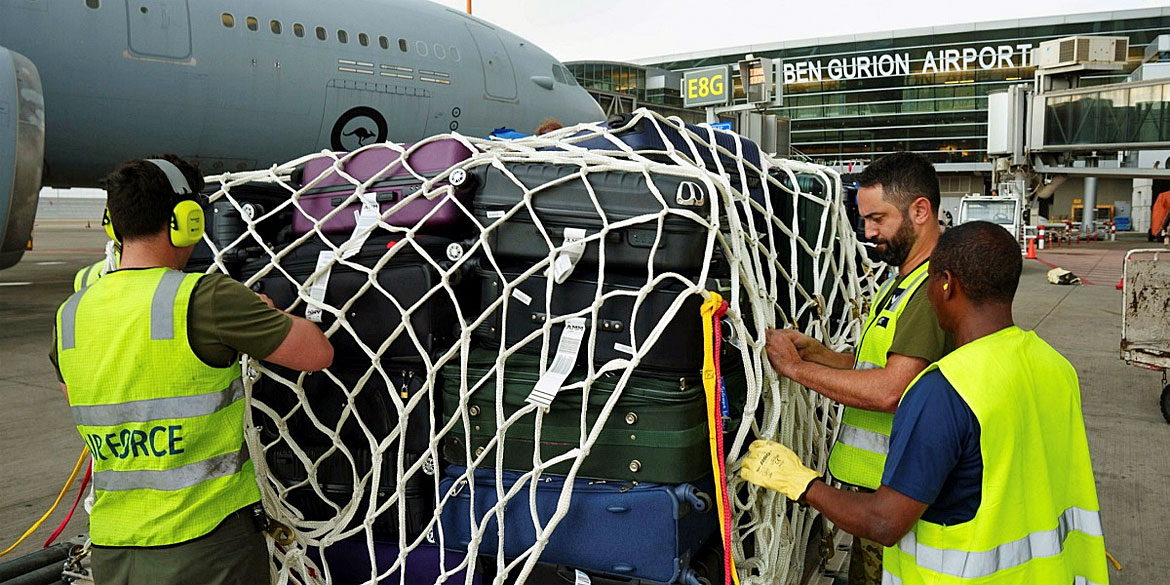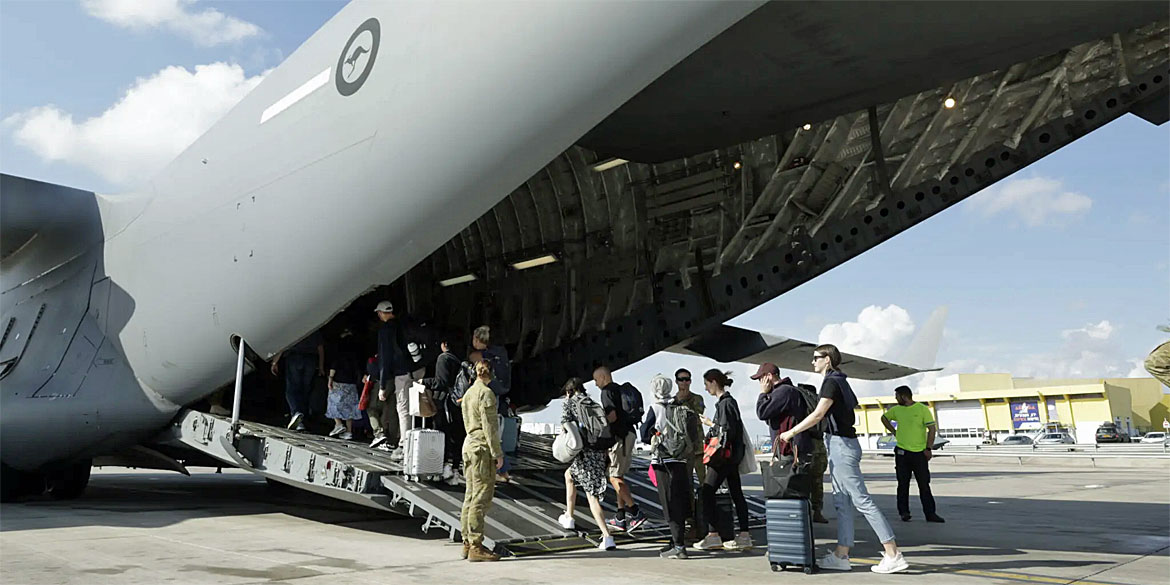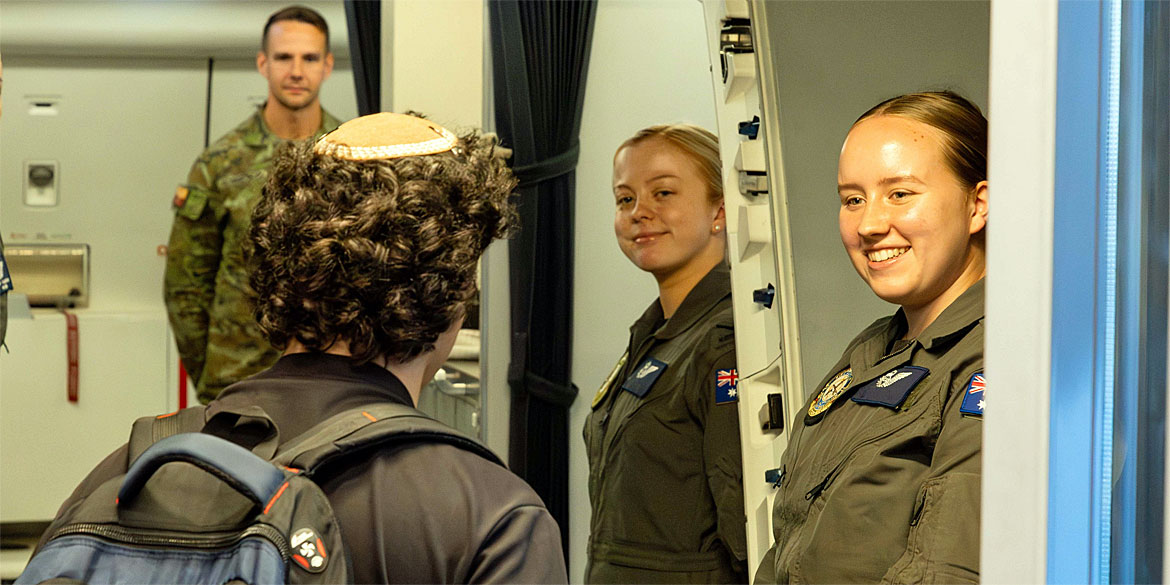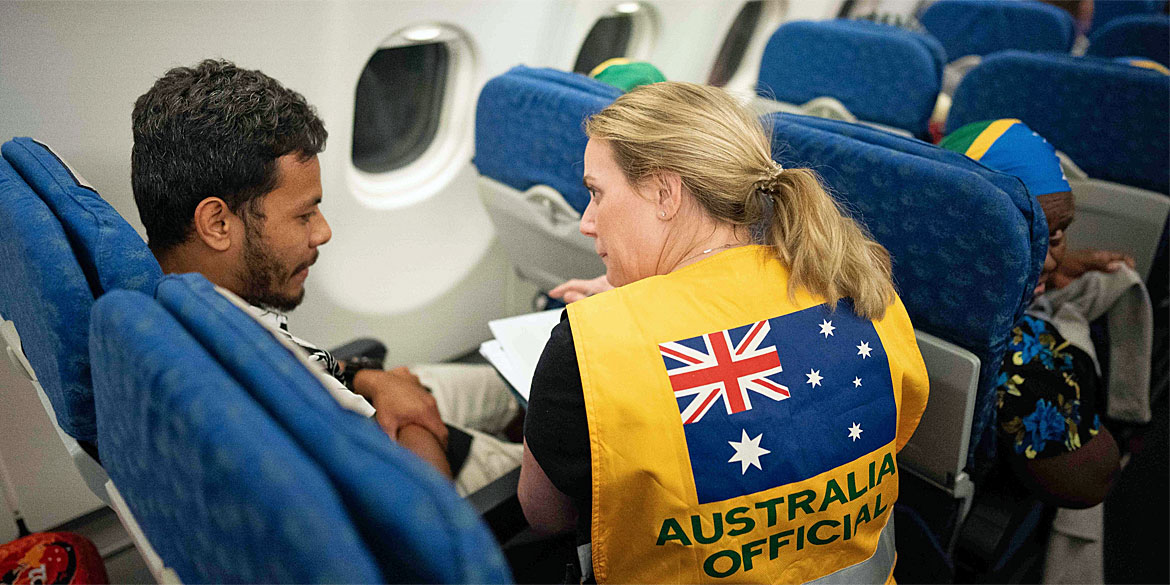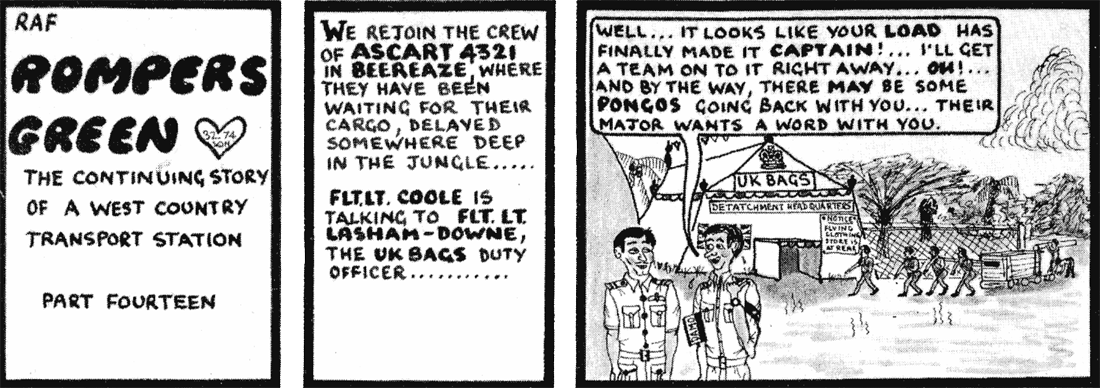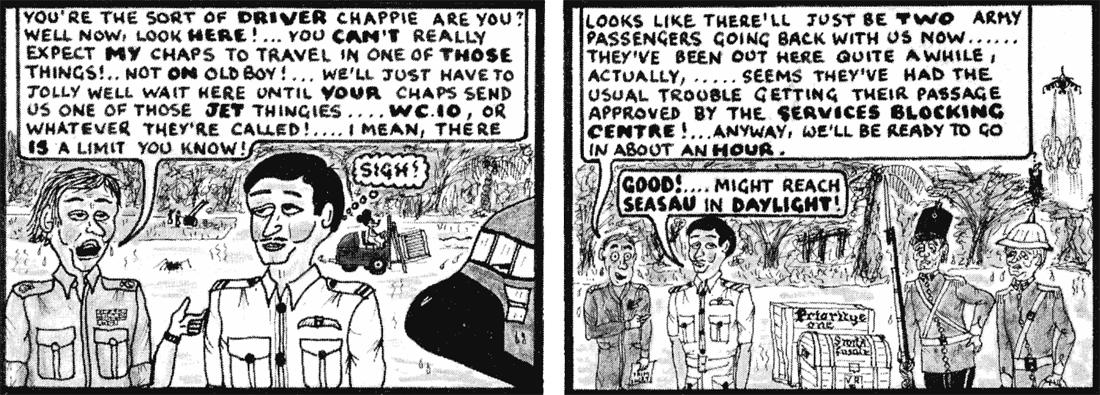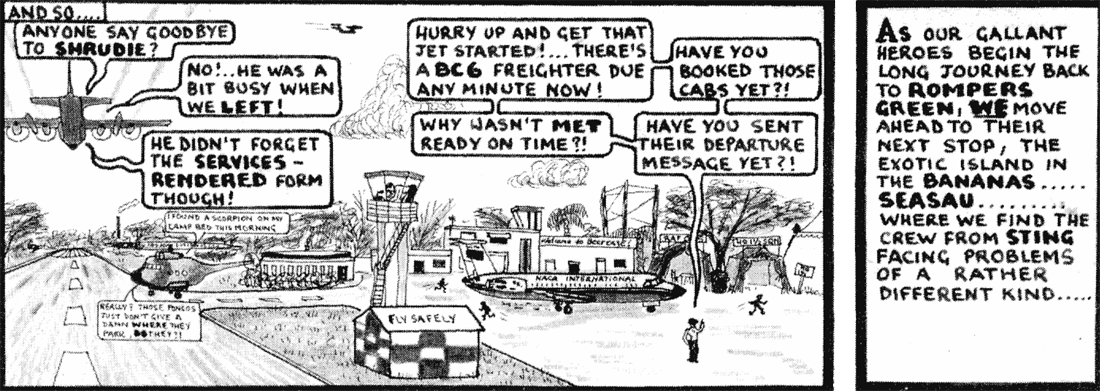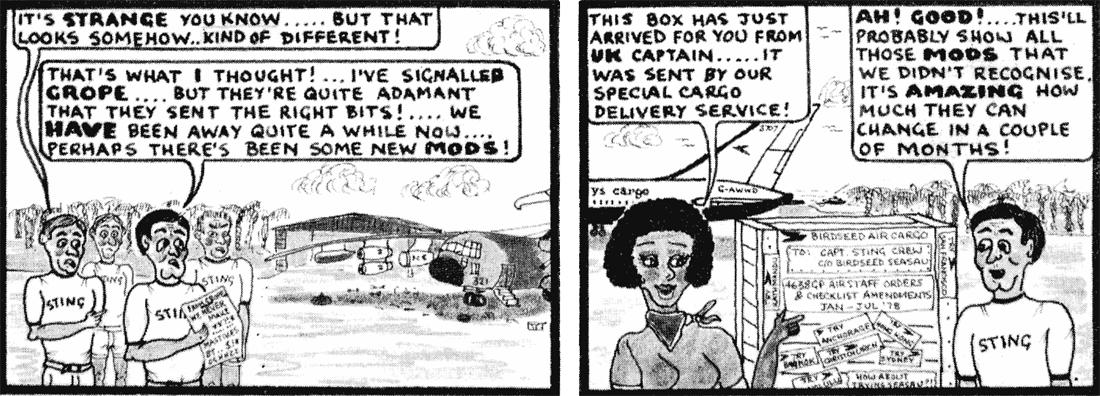
From: Graham Allen, Cropwell Butler, Notts
Subject: Post Air Force Careers
Hi Tony,
After I left the service, I got a job as a shipping manager for a small footwear designer company. Based in Loughborough, Leicester, I travelled extensively to Hong Kong, Taiwan, Pusan South Korea, Singapore and Italy. Great job - loved it! The company owner died suddenly and I was out of work. I then got a job as a Loadmaster working for Air Bridge Carriers /Hunting Airlines. Really enjoyed flying the old Lockheed Electra and the Merchantman. Lots of laughs with some great crews! Ended up as a Flight Manager with Antonov Design Bureau. Managed to fly to 59 countries in the first six months. Great bunch of lads to work with and enjoyed my time immensely.
My final job was with Servisair as a team leader. My contract was for 25 hours a week, which in reality was 100 hours plus a week. Everything was going fine until I threw a suitcase up to my mate to finish a load and my back ripped, I actually tore my sciatic nerve. I ended up paralysed for quite a while and had to learn to walk again. Sad way to finish doing a job I loved but no regrets, I’ve had a blast and met some really great people along the way!
Best Regards
Graham
Subject: Post Air Force Careers
Hi Tony,
After I left the service, I got a job as a shipping manager for a small footwear designer company. Based in Loughborough, Leicester, I travelled extensively to Hong Kong, Taiwan, Pusan South Korea, Singapore and Italy. Great job - loved it! The company owner died suddenly and I was out of work. I then got a job as a Loadmaster working for Air Bridge Carriers /Hunting Airlines. Really enjoyed flying the old Lockheed Electra and the Merchantman. Lots of laughs with some great crews! Ended up as a Flight Manager with Antonov Design Bureau. Managed to fly to 59 countries in the first six months. Great bunch of lads to work with and enjoyed my time immensely.
My final job was with Servisair as a team leader. My contract was for 25 hours a week, which in reality was 100 hours plus a week. Everything was going fine until I threw a suitcase up to my mate to finish a load and my back ripped, I actually tore my sciatic nerve. I ended up paralysed for quite a while and had to learn to walk again. Sad way to finish doing a job I loved but no regrets, I’ve had a blast and met some really great people along the way!
Best Regards
Graham

Australia Deploys Military Transport Aircraft to Evacuate People from Israel

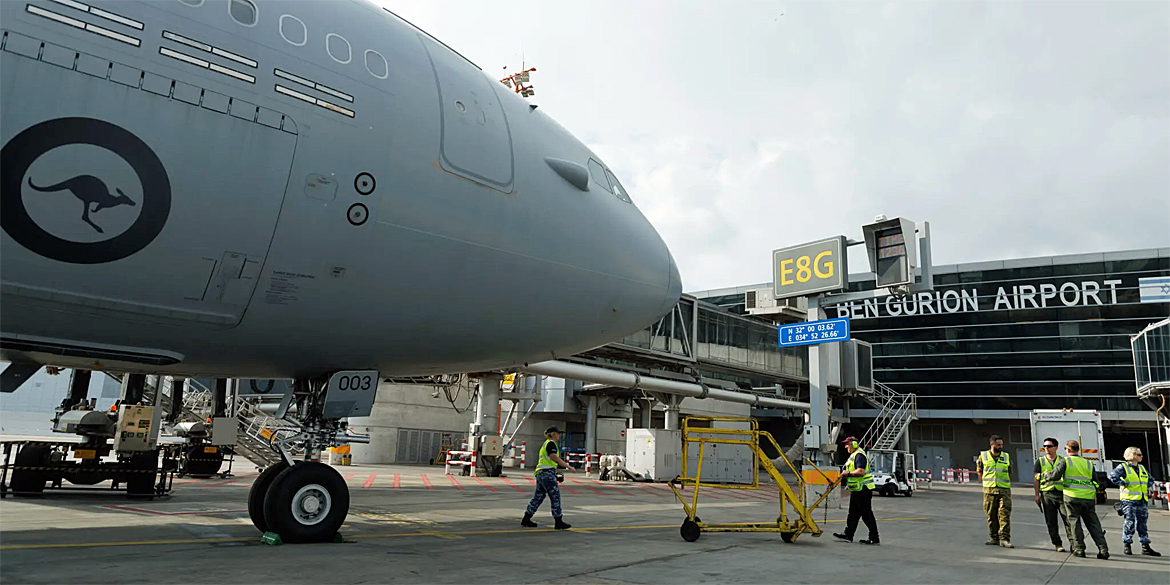
The Royal Australian Air Force is sending KC-30A and [2] C-17A Globemaster III transport planes to the Middle East for an airlift mission in response to the Hamas attacks. The mission is part of an ongoing government-supported private charter that flies Australian citizens and other country’s nationals from Israel’s Ben Gurion Airport to Dubai, UAE. Since the deployment commenced on October 13, a total of 236 people have been evacuated through the military-led departure flights.
Australian Deputy Prime Minister Richard Marles explained the steps the government is taking to ensure the safety of its people from the Israel-Hamas conflict. “The activation of two Defence aircraft provides critical options for Australia as the conflict in Israel continues to evolve,” the official said. “Australian nationals and visa holders who wish to leave Israel should ensure they are registered with DFAT [Department of Foreign Affairs and Trade] via their crisis portal.”
thedefensepost.com
Australian Deputy Prime Minister Richard Marles explained the steps the government is taking to ensure the safety of its people from the Israel-Hamas conflict. “The activation of two Defence aircraft provides critical options for Australia as the conflict in Israel continues to evolve,” the official said. “Australian nationals and visa holders who wish to leave Israel should ensure they are registered with DFAT [Department of Foreign Affairs and Trade] via their crisis portal.”
thedefensepost.com


From: Ian Berry, Eastleaze, Swindon, Wilts
Subject: Ian Place’s Request - Landrover 89AA89
Hi Tony,
In response to Ian's request, I have found the following picture taken in the UKMAMS Hangar at Abingdon. Ian's favourite beast is in the foreground.
It may be quite sad to some that we remember our team's Landrover registration, but those Movers that followed us fail to realise we had our own team vehicles. It's so sad that I remember ours - 85AA86 which is sadly not in the picture as no doubt we were on a drive-fly-drive task that day!
Ian
[Foxtrot Team's Landrover was 88AA81]
Subject: Ian Place’s Request - Landrover 89AA89
Hi Tony,
In response to Ian's request, I have found the following picture taken in the UKMAMS Hangar at Abingdon. Ian's favourite beast is in the foreground.
It may be quite sad to some that we remember our team's Landrover registration, but those Movers that followed us fail to realise we had our own team vehicles. It's so sad that I remember ours - 85AA86 which is sadly not in the picture as no doubt we were on a drive-fly-drive task that day!
Ian
[Foxtrot Team's Landrover was 88AA81]

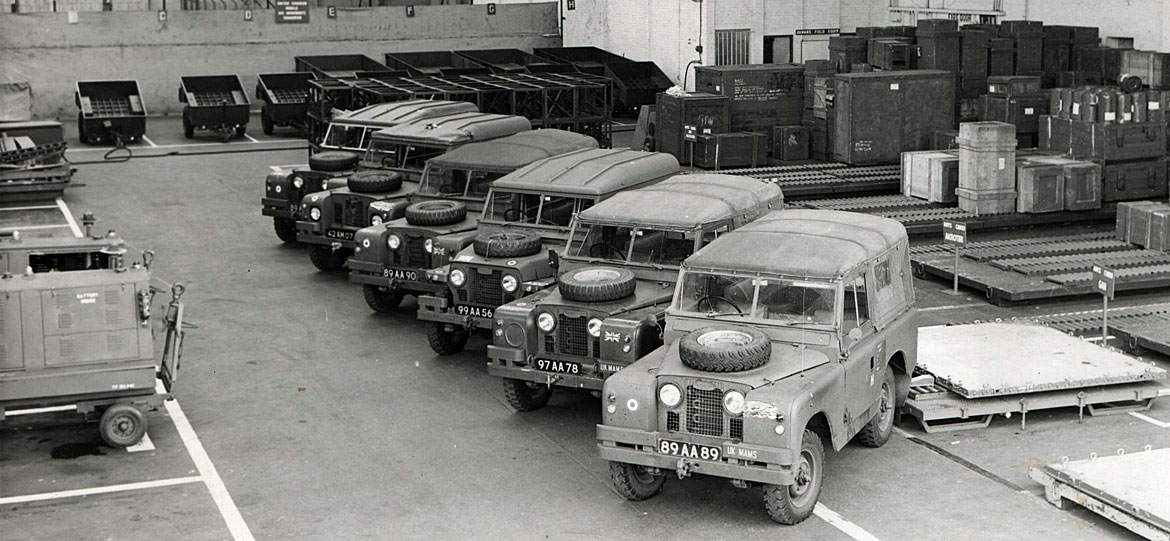

From: Mark Holland, Hodnet, Market Drayton, Salop
Subject: Food Stories from Around the World
Hi Tony,
Subject: Food Stories from Around the World
Hi Tony,
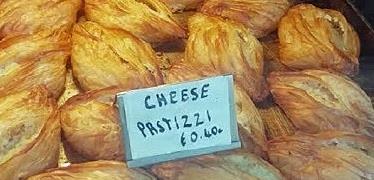

I don’t eat junk food (honest!) but do you remember the cheese pies sold on Valletta street corners, in those heated trolleys?
Now if they are still there, I would definitely subscribe to junk food again!
Kind regards
Mark
Now if they are still there, I would definitely subscribe to junk food again!
Kind regards
Mark

British aircraft lands near Polish border to supply Ukraine
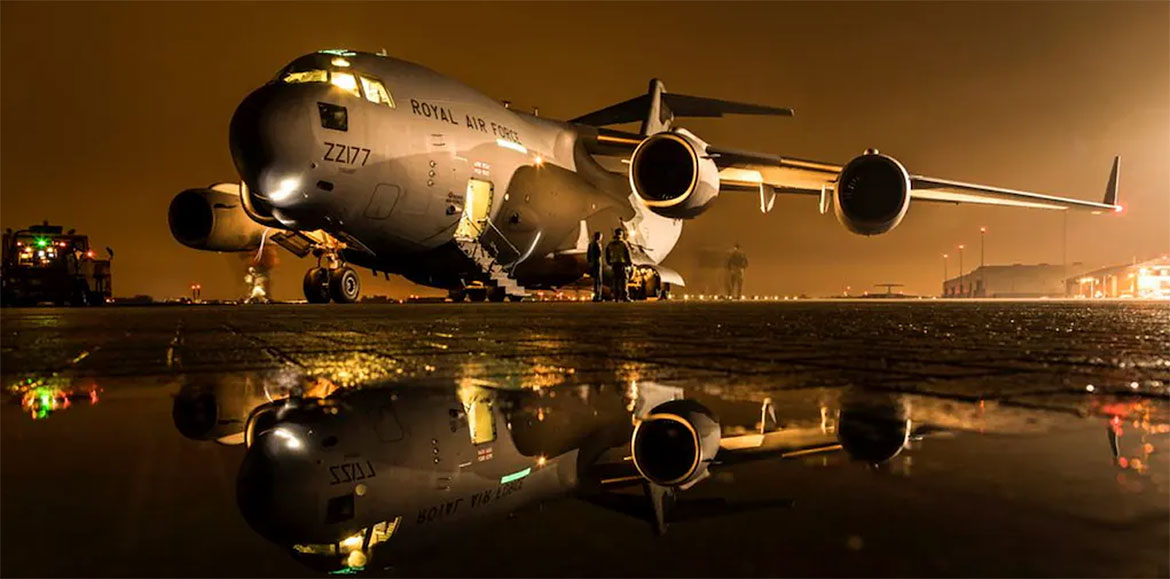
Royal Air Force C-17 flights supplying weapons, ammunition and other equipment started before the invasion and have not stopped since. However, after the invasion, they now land in Poland near the Ukrainian border for obvious reasons.
Recently, the United Kingdom pledged to supply Ukraine with “tens of thousands more artillery shells” this year. This comes on the back of an already significant delivery, with the UK having provided over 300,000 artillery shells to the nation.
During the 15th Ukraine Defence Contact Group (UDCG) meeting held at the US Air Force base in Ramstein, Germany, the Defence Secretary, alongside Chief of the Defence Staff (CDS), Admiral Sir Tony Radakin, reiterated the nation’s firm support. The UDCG, comprising representatives from nearly 50 countries, convenes to coordinate international assistance for Ukraine.
“Today we’ve demonstrated the UK’s unwavering commitment to Ukraine and set out more military support, including pledging tens of thousands more artillery shells to enable Ukraine to defend itself against Russia’s unprovoked invasion and to retake illegally occupied territories,” stated Defence Secretary Grant Shapps. He further highlighted plans to bolster support in priority areas such as air defence, long-range strike capabilities, and training as the winter months approach.
Admiral Sir Tony Radakin commented on the gathering’s significance, saying, “With representatives from 50 nations gathered in Ramstein today, President Putin should be worried. This is a tangible demonstration of the international community’s continued resolve to back Ukraine with the military support it requires through the winter and into 2024.”
To date, the UK has supplied more than 12,000 anti-tank weapons, 300,000 rounds of artillery ammunition, thousands of missiles, self-propelled artillery, and more than 200,000 pieces of non-lethal equipment, including extreme cold weather clothing, mine detection equipment, and industrial strength generators.
UK Defence Journal
Recently, the United Kingdom pledged to supply Ukraine with “tens of thousands more artillery shells” this year. This comes on the back of an already significant delivery, with the UK having provided over 300,000 artillery shells to the nation.
During the 15th Ukraine Defence Contact Group (UDCG) meeting held at the US Air Force base in Ramstein, Germany, the Defence Secretary, alongside Chief of the Defence Staff (CDS), Admiral Sir Tony Radakin, reiterated the nation’s firm support. The UDCG, comprising representatives from nearly 50 countries, convenes to coordinate international assistance for Ukraine.
“Today we’ve demonstrated the UK’s unwavering commitment to Ukraine and set out more military support, including pledging tens of thousands more artillery shells to enable Ukraine to defend itself against Russia’s unprovoked invasion and to retake illegally occupied territories,” stated Defence Secretary Grant Shapps. He further highlighted plans to bolster support in priority areas such as air defence, long-range strike capabilities, and training as the winter months approach.
Admiral Sir Tony Radakin commented on the gathering’s significance, saying, “With representatives from 50 nations gathered in Ramstein today, President Putin should be worried. This is a tangible demonstration of the international community’s continued resolve to back Ukraine with the military support it requires through the winter and into 2024.”
To date, the UK has supplied more than 12,000 anti-tank weapons, 300,000 rounds of artillery ammunition, thousands of missiles, self-propelled artillery, and more than 200,000 pieces of non-lethal equipment, including extreme cold weather clothing, mine detection equipment, and industrial strength generators.
UK Defence Journal

From: Mike/Gerry Lefebvre, Oromocto, NB
Subject: Food Stories from Around the World
Tony,
This happened in the early seventies, while at 436 SQN Trenton, Ontario. We were night stopping in Iceland, which was unusual for us. We stayed in a Bed and Breakfast (I don’t think they called it that then).
As we sat down for supper, to our surprise there was whale listed. So, we all agreed to have it for dinner. We sat, drank and waited for our meal. Eventually the lady came walking in with a large platter in her hands with a silver lid covering the contents.
She put the platter on the table and removed the cover. All our jaws dropped as we realized it was just like a roast of beef. Then came the realisation that a whale is a mammal and not a fish. We all enjoyed our meal after our original surprise.
Mike
Subject: Food Stories from Around the World
Tony,
This happened in the early seventies, while at 436 SQN Trenton, Ontario. We were night stopping in Iceland, which was unusual for us. We stayed in a Bed and Breakfast (I don’t think they called it that then).
As we sat down for supper, to our surprise there was whale listed. So, we all agreed to have it for dinner. We sat, drank and waited for our meal. Eventually the lady came walking in with a large platter in her hands with a silver lid covering the contents.
She put the platter on the table and removed the cover. All our jaws dropped as we realized it was just like a roast of beef. Then came the realisation that a whale is a mammal and not a fish. We all enjoyed our meal after our original surprise.
Mike


From: Liam Devlin, Port Talbot, West Glamorgan
Subject: Food Stories from Around the World
Hi Tony,
In 1964, as part of a FEAF MAMS team we were in Tawau, North Borneo. We had no set accommodation so we were moved around the town by the Brigade Major and food was limited to the usual Compo Rations. One night, as a treat, we went to a local restaurant for a meal; naturally the menu was not in English. I spotted something called STEK. Ahh a steak, that’s for me! It turns out the STEK was in fact tuna! I can’t abide seafood, but it was different to Compo so I forced myself to eat it. Ugh - never again!
The second episode was in Bardufoss, Norway. I was on detachment there and being fed by the Norwegian Army. After a particularly long day without having anything to eat, went off to the mess where there was a stew on the menu. It was take it or leave it as it was the only thing being served. Wolfed down a large portion without it touching the sides. Noticed it tasted different to anything I’d tasted before. I asked the chef what it was, he couldn’t speak English, but graphically described it, “Whale meat” My stomach recoiled, but I managed to keep it down.
Still wary of anything remotely like sea food, but I survived both experiences.
Regards,
Liam
Subject: Food Stories from Around the World
Hi Tony,
In 1964, as part of a FEAF MAMS team we were in Tawau, North Borneo. We had no set accommodation so we were moved around the town by the Brigade Major and food was limited to the usual Compo Rations. One night, as a treat, we went to a local restaurant for a meal; naturally the menu was not in English. I spotted something called STEK. Ahh a steak, that’s for me! It turns out the STEK was in fact tuna! I can’t abide seafood, but it was different to Compo so I forced myself to eat it. Ugh - never again!
The second episode was in Bardufoss, Norway. I was on detachment there and being fed by the Norwegian Army. After a particularly long day without having anything to eat, went off to the mess where there was a stew on the menu. It was take it or leave it as it was the only thing being served. Wolfed down a large portion without it touching the sides. Noticed it tasted different to anything I’d tasted before. I asked the chef what it was, he couldn’t speak English, but graphically described it, “Whale meat” My stomach recoiled, but I managed to keep it down.
Still wary of anything remotely like sea food, but I survived both experiences.
Regards,
Liam


From: John Leek, La Ronde
Subject: Food Stories from Around the World
Hi Tony,
Having had tours in Aden (twice!), Cyprus, Singapore and Hong Kong - no one food stands out above the other super delicacies. However, one place that sticks in my mind is the Airmans' Mess at Kidbrooke - home cooking with a choice!
Regards
John
Subject: Food Stories from Around the World
Hi Tony,
Having had tours in Aden (twice!), Cyprus, Singapore and Hong Kong - no one food stands out above the other super delicacies. However, one place that sticks in my mind is the Airmans' Mess at Kidbrooke - home cooking with a choice!
Regards
John


Australia Aids Papua New Guinea Air Ops With C-27J Aircraft
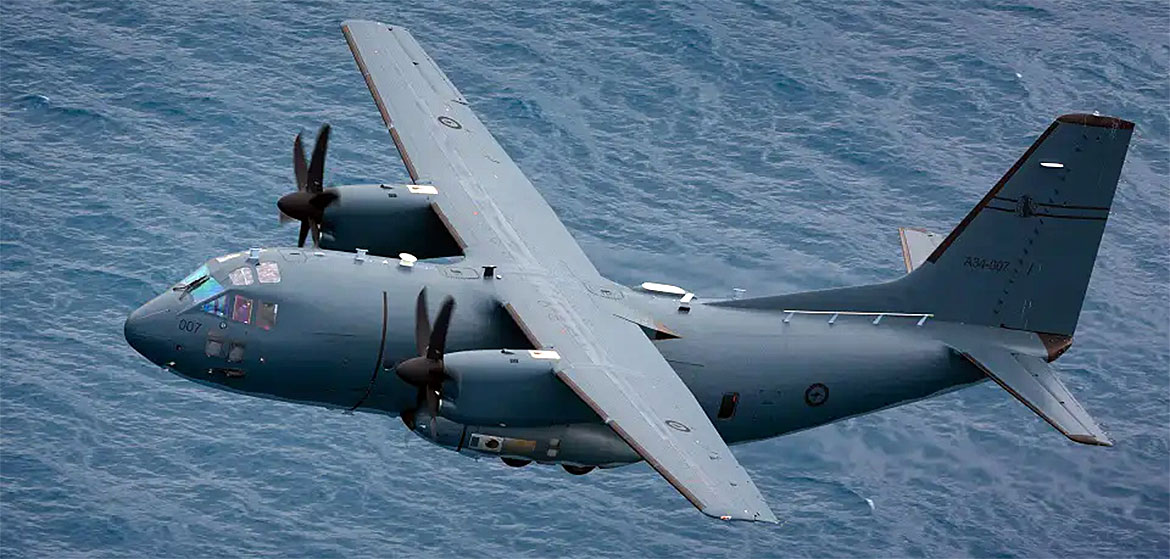
The Royal Australian Air Force (RAAF) has sent a C-27J Spartan to Papua New Guinea to integrate the military transport aircraft’s capabilities with the country’s PAC-750 aircraft. The deployment was part of the Defence Pacific Air Program, an Australian initiative that seeks to coordinate Pacific militaries and security agencies to promote peace in the region. The Spartan rotations ran from July to August and late August to early October.
84 Wing Group Commanding Officer Captain Matt Cooper said that the crew collaborated with the Papua New Guinea Defence Force (PNGDF) in various missions during the first deployment. “Early in the detachment, PNGDF members were taken on a familiarization flight to develop their understanding of C-27J Spartan capabilities,” he said. "The detachment established training and interoperability opportunities for PNGDF Air Movements personnel at less-prepared and remote airfields accessible to the Spartan.”
Practical drills were also conducted to test PNGDF’s preparedness in integrating two PAC-750XL utility aircraft to the force, which were shipped from Australia earlier this year. Before redeploying to Australia, the detachment played a crucial role in responding to the August Mount Bagana volcanic eruption in Bougainville. The Australian team collaborated with PNGDF and delivered humanitarian aid and disaster relief supplies to local communities. The C-27J was also used to evacuate citizens from remote areas.
“The most rewarding tasking was being on the first aircraft to deliver [humanitarian assistance and disaster relief] supplies to Bougainville,” 35 Squadron loadmaster Corporal Deniele Oehm stated, expanding on the importance of collaboration and cohesiveness between the two countries. “The effort the whole crew put in to deliver this outcome on one of our final days was a momentous achievement and the locals were so grateful for the supplies.”
The Defence Pacific Air Program allows the RAAF to continue coordinating with Papua New Guinea’s government agencies to promote interoperability in times of natural crisis.
thedefensepost.com
84 Wing Group Commanding Officer Captain Matt Cooper said that the crew collaborated with the Papua New Guinea Defence Force (PNGDF) in various missions during the first deployment. “Early in the detachment, PNGDF members were taken on a familiarization flight to develop their understanding of C-27J Spartan capabilities,” he said. "The detachment established training and interoperability opportunities for PNGDF Air Movements personnel at less-prepared and remote airfields accessible to the Spartan.”
Practical drills were also conducted to test PNGDF’s preparedness in integrating two PAC-750XL utility aircraft to the force, which were shipped from Australia earlier this year. Before redeploying to Australia, the detachment played a crucial role in responding to the August Mount Bagana volcanic eruption in Bougainville. The Australian team collaborated with PNGDF and delivered humanitarian aid and disaster relief supplies to local communities. The C-27J was also used to evacuate citizens from remote areas.
“The most rewarding tasking was being on the first aircraft to deliver [humanitarian assistance and disaster relief] supplies to Bougainville,” 35 Squadron loadmaster Corporal Deniele Oehm stated, expanding on the importance of collaboration and cohesiveness between the two countries. “The effort the whole crew put in to deliver this outcome on one of our final days was a momentous achievement and the locals were so grateful for the supplies.”
The Defence Pacific Air Program allows the RAAF to continue coordinating with Papua New Guinea’s government agencies to promote interoperability in times of natural crisis.
thedefensepost.com

From: Bryan Morgan, Abingdon, Oxon
Subject: Food Stories from Around the World
Tony,
Although I travelled widely on my tour on UKMAMS from 1971 to 1974 it did not compare with the visits I made when, at HQSTC a few years later, I was involved in the possible deployments of our strike aircraft to NATO airfields if the balloon ever went up. This involved inspections of around twenty or more airfields with separate discussions at associated Air Force headquarters.
My parish ranged from Tromso, north of the Arctic circle in Norway, to Erzurum in Eastern Turkey. I rarely stayed at the sites I was visiting so I had to rely on Rate 1 allowances to pay for my overnight accommodation. These rates varied from £41 per night in Norway to £7 in Turkey. As you can imagine food was extremely varied but my fondest memory was having supper one sunny evening which comprised the best pizza I have ever tasted along with a super pint of lager. The venue, which might surprise, was downtown Oslo!
Regards,
Bryan
Subject: Food Stories from Around the World
Tony,
Although I travelled widely on my tour on UKMAMS from 1971 to 1974 it did not compare with the visits I made when, at HQSTC a few years later, I was involved in the possible deployments of our strike aircraft to NATO airfields if the balloon ever went up. This involved inspections of around twenty or more airfields with separate discussions at associated Air Force headquarters.
My parish ranged from Tromso, north of the Arctic circle in Norway, to Erzurum in Eastern Turkey. I rarely stayed at the sites I was visiting so I had to rely on Rate 1 allowances to pay for my overnight accommodation. These rates varied from £41 per night in Norway to £7 in Turkey. As you can imagine food was extremely varied but my fondest memory was having supper one sunny evening which comprised the best pizza I have ever tasted along with a super pint of lager. The venue, which might surprise, was downtown Oslo!
Regards,
Bryan


From: Jim Nadin, Lincoln
Subject: Food Stories from Around the World
Hello Tony,
Once again, many thanks for your sterling efforts in pulling together the OBA newsletter, always a good read from start to finish.
Food has always been a favourite topic of mine and I believe the ratio of absolute rubbish versus outstanding military food is about 80/20. I recall many trips to restaurants in Manama to make up for the swill we were served daily in the Mess. Monkey brains featured one memorable evening in the old airport restaurant but our favourite was probably Pop's goat keema. Then on the first leg of our trip from Bahrain back to the UK by Argosy, the loadmaster jettisoned the entire collection of in-flight rations into the Persian Gulf. Yes, they were that bad!
Mezes in Cyprus, outstanding curries in Sri Lanka, disappointing bland fare in the USA for 3 weeks in the Dulles Marriott, the best pizza ever in the Aviano USAF Mess Hall all added to a wide ranging culinary experience. Perhaps the most bizarre was breakfast with the Commandant German Air Force Base Fassberg. Firstly his wife served an English breakfast comprising 6 fried eggs combined with crisp streaky bacon and beans for each of us. Very good indeed until the next course followed which was a full German fruhshtuk of raw fish, garlic cloves, chillies, bread, cheese, ham and accompanied by bottles of Weiss Bier.
I think the most memorable meal was when I worked with a certain aerobatic team. They were in Cyprus and had left their visas behind as they were flying out to the Middle East and no visa meant no entry. Well someone had to do the job so I was booked on the Friday lunchtime flight from LHR to Dar-es-Salaam via Limassol, but first class being the only option. What I didn't know was that this would be the final BA VC-10 trip on this route. The entire journey out and return was a gourmet's delight and an alcoholics dream come true. My second G&T was in my hand as we took off, they kept coming until a half bottle of Sancerre accompanied the Lobster Bisque entree, followed by a perfectly cooked filet mignon with a half bottle of Claret. Dessert was a raspberry torte with a thick cream and yes, a half bottle of dessert wine was followed by cognac. The return flight was just as good but with a different menu. I am only pleased that I was met at LHR!
Therefore I consider myself to have been extremely fortunate to have eaten well on many occasions but mostly outside of the military environment. The only unfortunate incident being when several of us had been taken to a top notch Italian restaurant and during the inevitable zambucca drinking competition, one of our party dropped his glass of flaming alcohol setting the table cloth alight as well as his trousers!
Best wishes,
Jim
Subject: Food Stories from Around the World
Hello Tony,
Once again, many thanks for your sterling efforts in pulling together the OBA newsletter, always a good read from start to finish.
Food has always been a favourite topic of mine and I believe the ratio of absolute rubbish versus outstanding military food is about 80/20. I recall many trips to restaurants in Manama to make up for the swill we were served daily in the Mess. Monkey brains featured one memorable evening in the old airport restaurant but our favourite was probably Pop's goat keema. Then on the first leg of our trip from Bahrain back to the UK by Argosy, the loadmaster jettisoned the entire collection of in-flight rations into the Persian Gulf. Yes, they were that bad!
Mezes in Cyprus, outstanding curries in Sri Lanka, disappointing bland fare in the USA for 3 weeks in the Dulles Marriott, the best pizza ever in the Aviano USAF Mess Hall all added to a wide ranging culinary experience. Perhaps the most bizarre was breakfast with the Commandant German Air Force Base Fassberg. Firstly his wife served an English breakfast comprising 6 fried eggs combined with crisp streaky bacon and beans for each of us. Very good indeed until the next course followed which was a full German fruhshtuk of raw fish, garlic cloves, chillies, bread, cheese, ham and accompanied by bottles of Weiss Bier.
I think the most memorable meal was when I worked with a certain aerobatic team. They were in Cyprus and had left their visas behind as they were flying out to the Middle East and no visa meant no entry. Well someone had to do the job so I was booked on the Friday lunchtime flight from LHR to Dar-es-Salaam via Limassol, but first class being the only option. What I didn't know was that this would be the final BA VC-10 trip on this route. The entire journey out and return was a gourmet's delight and an alcoholics dream come true. My second G&T was in my hand as we took off, they kept coming until a half bottle of Sancerre accompanied the Lobster Bisque entree, followed by a perfectly cooked filet mignon with a half bottle of Claret. Dessert was a raspberry torte with a thick cream and yes, a half bottle of dessert wine was followed by cognac. The return flight was just as good but with a different menu. I am only pleased that I was met at LHR!
Therefore I consider myself to have been extremely fortunate to have eaten well on many occasions but mostly outside of the military environment. The only unfortunate incident being when several of us had been taken to a top notch Italian restaurant and during the inevitable zambucca drinking competition, one of our party dropped his glass of flaming alcohol setting the table cloth alight as well as his trousers!
Best wishes,
Jim


From: Chris Goss, Marlow, Bucks
Subject: Food Stories from Around the World
Four stick in my memory Tony:
1. Getting food poisoning from a pizza in Sicily and then going down with it big time at the Carnivore in Nairobi. I was so looking forwards to the meaty feast that I offered to drive, but then spent the whole meal in the toilets.
2. Agreeing with Steve Perry and SAC Dave Spencer that we would have a foodie time in Saskatoon and would aim to spend our full daily allowance just on food - we failed!
3. Wondering why the allowances were so high in Addis Ababa (Op Bushell) when you could not find a decent restaurant (thanks FCO!). Bruce Philips and his Sgt lived on Pot Noodles for the month they were there - classic.
4. Didn't Simon Baxter win the award for exceeding actuals (a maximum amount you would pay rather than an allowance per person) on a Norway trip? Bloody hard to do and should have got a medal!
Best regards
Chris
Subject: Food Stories from Around the World
Four stick in my memory Tony:
1. Getting food poisoning from a pizza in Sicily and then going down with it big time at the Carnivore in Nairobi. I was so looking forwards to the meaty feast that I offered to drive, but then spent the whole meal in the toilets.
2. Agreeing with Steve Perry and SAC Dave Spencer that we would have a foodie time in Saskatoon and would aim to spend our full daily allowance just on food - we failed!
3. Wondering why the allowances were so high in Addis Ababa (Op Bushell) when you could not find a decent restaurant (thanks FCO!). Bruce Philips and his Sgt lived on Pot Noodles for the month they were there - classic.
4. Didn't Simon Baxter win the award for exceeding actuals (a maximum amount you would pay rather than an allowance per person) on a Norway trip? Bloody hard to do and should have got a medal!
Best regards
Chris


Aviation Procurement: Winging it? – Report Summary, 10 September 2023
This is a House of Commons Committee report, with recommendations to government. The Government has two months to respond.
2021’s Defence Command Paper, Defence in a Competitive Age, made significant cuts to the UK’s air power capabilities, with some aircraft to be retired early and plans to purchase replacements scaled back. Less than one year later, Russia’s full-scale invasion of Ukraine brought the implications of these cuts into sharp focus. The UK’s diminished air capability has left it dangerously exposed in the face of what the MoD has described as “the greatest threat to the open international order in decades”.1 Despite this, July’s Defence Command Paper Refresh did not reverse any of the 2021 cuts.
There are serious questions as to whether the UK’s diminished combat air fleet can successfully deter and defend against enemy aggression. Whilst made up of highly capable aircraft, it is just too small to withstand the levels of attrition that would occur in a peer-on-peer war. The imminent retirement of the Tranche 1 Typhoon and continued slow force growth of the F-35 fleet will only exacerbate these shortcomings: the MoD and RAF must urgently address this lack of combat mass.
The retirement of the E-3D Sentry has left the UK without a land-based fixed-wing Airborne Early Warning & Control capability. This capability gap has already been extended as the in-service date for the Sentry’s replacement, the E-7A Wedgetail, has slipped by a year. Moreover, when the Wedgetail does eventually enter service, it will be as a reduced fleet of just three aircraft rather than the five originally ordered. The cost savings which the MoD cited to justify this cut are disproportionate to the significant reduction in capability which it will entail, and the Department must reverse this irrational decision at the earliest possible opportunity.
The MoD’s decision to retire the C-130J Hercules some seven years before its planned out-of-service date will severely reduce the overall capacity of the RAF’s air mobility fleet, which provides critical support to operations across Defence as well as fulfilling a humanitarian role, and will have a particular impact on our Special Forces.
Persistent and unacceptable delays in the flying training pipeline mean that pilots are waiting years to qualify, with serious implications for morale and for the effectiveness of our armed forces. We will hold the MoD and the RAF’s senior leadership accountable for bringing these delays within acceptable limits by mid-2024. They must ensure that the system has sufficient flexibility and resilience to adapt to future changes in aircrew requirements without introducing further delay, and should review and streamline contractual arrangements to improve transparency and accountability.
UK Parliament (Thanks to Rob Davies)
2021’s Defence Command Paper, Defence in a Competitive Age, made significant cuts to the UK’s air power capabilities, with some aircraft to be retired early and plans to purchase replacements scaled back. Less than one year later, Russia’s full-scale invasion of Ukraine brought the implications of these cuts into sharp focus. The UK’s diminished air capability has left it dangerously exposed in the face of what the MoD has described as “the greatest threat to the open international order in decades”.1 Despite this, July’s Defence Command Paper Refresh did not reverse any of the 2021 cuts.
There are serious questions as to whether the UK’s diminished combat air fleet can successfully deter and defend against enemy aggression. Whilst made up of highly capable aircraft, it is just too small to withstand the levels of attrition that would occur in a peer-on-peer war. The imminent retirement of the Tranche 1 Typhoon and continued slow force growth of the F-35 fleet will only exacerbate these shortcomings: the MoD and RAF must urgently address this lack of combat mass.
The retirement of the E-3D Sentry has left the UK without a land-based fixed-wing Airborne Early Warning & Control capability. This capability gap has already been extended as the in-service date for the Sentry’s replacement, the E-7A Wedgetail, has slipped by a year. Moreover, when the Wedgetail does eventually enter service, it will be as a reduced fleet of just three aircraft rather than the five originally ordered. The cost savings which the MoD cited to justify this cut are disproportionate to the significant reduction in capability which it will entail, and the Department must reverse this irrational decision at the earliest possible opportunity.
The MoD’s decision to retire the C-130J Hercules some seven years before its planned out-of-service date will severely reduce the overall capacity of the RAF’s air mobility fleet, which provides critical support to operations across Defence as well as fulfilling a humanitarian role, and will have a particular impact on our Special Forces.
Persistent and unacceptable delays in the flying training pipeline mean that pilots are waiting years to qualify, with serious implications for morale and for the effectiveness of our armed forces. We will hold the MoD and the RAF’s senior leadership accountable for bringing these delays within acceptable limits by mid-2024. They must ensure that the system has sufficient flexibility and resilience to adapt to future changes in aircrew requirements without introducing further delay, and should review and streamline contractual arrangements to improve transparency and accountability.
UK Parliament (Thanks to Rob Davies)

From: Stephen Davey, Tadcaster, North Yorks
Subject: Food Stories from Around the World
Tony,
Once again I had to delve deep into my memory banks for this one but managed in the end, May 1970 Air Movements Training School, our organised trip was a Belfast from Brize Norton to Akrotiri via RAF Luqa in Malta. When we arrived at Akrotiri, our team had about six hours to kill so we went to Limassol for some R & R. Whilst there we went to a restaurant for lunch and I tried the swordfish steak (this is probably frowned upon these days). Anyway, I right enjoyed it as it was the only time I had it!
Regards
Steve
Subject: Food Stories from Around the World
Tony,
Once again I had to delve deep into my memory banks for this one but managed in the end, May 1970 Air Movements Training School, our organised trip was a Belfast from Brize Norton to Akrotiri via RAF Luqa in Malta. When we arrived at Akrotiri, our team had about six hours to kill so we went to Limassol for some R & R. Whilst there we went to a restaurant for lunch and I tried the swordfish steak (this is probably frowned upon these days). Anyway, I right enjoyed it as it was the only time I had it!
Regards
Steve


From: Don Hunter, Saint Quentin de Caplong
Subject: Food Stories from Around the World
Hi Tony,
A Herc task from Patrick AFB to Barksdale AFB, en route to Giant Voice, 1974. The usual "gobblybox" provided: cold chicken, sugary drink, chewing gum, bit of cake and then something I have never forgotten.
An "interdental stimulator" at the bottom of the cardboard box. WTF? (or similar) I thought. These Americans think of everything for their boys, but no. It was of course a toothpick.
Only in America.
All best wishes
Don
Subject: Food Stories from Around the World
Hi Tony,
A Herc task from Patrick AFB to Barksdale AFB, en route to Giant Voice, 1974. The usual "gobblybox" provided: cold chicken, sugary drink, chewing gum, bit of cake and then something I have never forgotten.
An "interdental stimulator" at the bottom of the cardboard box. WTF? (or similar) I thought. These Americans think of everything for their boys, but no. It was of course a toothpick.
Only in America.
All best wishes
Don


From: Andy Downard, Ballarat, VIC
Subject: Food Stories from Around the World
Hi Tony,
I’m going to go off on a couple of tangents with your subject this month, but will start with my first experience of (relatively) fine dining. Our DAMO in Muharraq decided that the entire shift should go to the restaurant in the Passenger Terminal on the civilian side. His recommendation, which I took up, was the ‘Steak Diane’. For a 19-year-old Londoner who had previously thought Wimpy’s was a restaurant, it was an eye-opener. Cooked at the table with flames; the full works, it was a whole new experience!
The first of the tangents is the Airmans' Mess in Muharraq. The memory of what was called ‘Injected Eggs’ still stays with me; the taste was appalling. However, we learned not to complain about it because once a month, there would be ice cream at lunchtime. To ensure discipline, the WO in charge of the mess would take on the role of serving the ice cream. If you had made trouble for his cooks in the last month, your server would miss the bowl, and you’d be told to move on!
Subject: Food Stories from Around the World
Hi Tony,
I’m going to go off on a couple of tangents with your subject this month, but will start with my first experience of (relatively) fine dining. Our DAMO in Muharraq decided that the entire shift should go to the restaurant in the Passenger Terminal on the civilian side. His recommendation, which I took up, was the ‘Steak Diane’. For a 19-year-old Londoner who had previously thought Wimpy’s was a restaurant, it was an eye-opener. Cooked at the table with flames; the full works, it was a whole new experience!
The first of the tangents is the Airmans' Mess in Muharraq. The memory of what was called ‘Injected Eggs’ still stays with me; the taste was appalling. However, we learned not to complain about it because once a month, there would be ice cream at lunchtime. To ensure discipline, the WO in charge of the mess would take on the role of serving the ice cream. If you had made trouble for his cooks in the last month, your server would miss the bowl, and you’d be told to move on!

On Gan, the Pakistani camp was a location where a really good curry banquet could be put on, and the Movers were fairly regular visitors (we didn’t want Ian Envis to fade away😉). Gan was also where the reality of being a long way from anywhere from a food point of view was brought home.
While some of the members of this group were having lots of fun in Cyprus in the mid-70s, on Gan, we were faced with a double whammy: firstly, the transiting aircraft stopped, and secondly, the regular supply vessel was late. This meant a shift to consuming the bulk compo rations for a few weeks. Surprisingly, it tasted pretty good, and there were few complaints from the troops!
While some of the members of this group were having lots of fun in Cyprus in the mid-70s, on Gan, we were faced with a double whammy: firstly, the transiting aircraft stopped, and secondly, the regular supply vessel was late. This meant a shift to consuming the bulk compo rations for a few weeks. Surprisingly, it tasted pretty good, and there were few complaints from the troops!
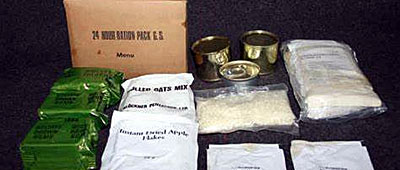
Staying with Gan, the next tangent is the universal “Tea Swindle”! Every shift, team and barrack block had its own Tea Swindle. On Gan, the Movers block had a room with fewer inhabitants and the Tea Swindle was stored there in a spare bedside locker. The first incident was after a report of scratching and scuffling in the locker a team of ‘exterminators’ with sticks and brooms attended. Forming a semi-circle around the locker, the door was flung open. Sitting in the locker snacking on the sugar was a rat! We stared at it, it stared at us, and nobody moved. Seeking to break the deadlock Dave Whyke thrust his stick at the rat, who immediately ran up the stick over Dave’s shoulder, down his back and out the door. It must have been a full minute before Dave even moved. The next time there was a similar report, an even larger contingent turned up, heavily armed. On flinging the door open, we saw a thumb-sized cockroach. it jumped in the air and spun to face us, and a nervous voice from the back of the group announced, “It's seen us!”
Cyprus was also a top food destination. Sitting in the NAAFI at closing time, the dreaded words might be spoken: “Anyone fancy a kebab?” This meant a taxi to the local village for a full or half ‘kebab’. The full kebab was a carnivore's delight: Greek sausage, liver, chops, local bread and salad. Importantly, it also came with as much free Kokkinelli (just Red in Greek) as you could drink. This would lead to further bad decision-making, which would have you heading to the disco’s in Limassol, getting back just in time to get changed and heading to work at 4:00 a.m. (where we got to cook our own breakfast in the Inflight Catering kitchen, never fried up so much stuff since!) The other food option in Cyprus was the Greek Fish Meze sitting on the harbour wall at Paphos. The fish came straight off the boat, into the restaurant and onto your plate. Again, more helpings than you could manage.
So yes, travelling the world with Movements did open up some culinary delights, from chicken satay’s from a street vendor in Singapore, the schnitzel breakfast from the Flugelhof café at the gates of RAF Gutersloh on our way back to camp after a big night, or the favourite of one of our gang in Cyprus on the way back to camp, Spaghetti Hoops on toast, pheff who needs Steak Diane!
Andy
Cyprus was also a top food destination. Sitting in the NAAFI at closing time, the dreaded words might be spoken: “Anyone fancy a kebab?” This meant a taxi to the local village for a full or half ‘kebab’. The full kebab was a carnivore's delight: Greek sausage, liver, chops, local bread and salad. Importantly, it also came with as much free Kokkinelli (just Red in Greek) as you could drink. This would lead to further bad decision-making, which would have you heading to the disco’s in Limassol, getting back just in time to get changed and heading to work at 4:00 a.m. (where we got to cook our own breakfast in the Inflight Catering kitchen, never fried up so much stuff since!) The other food option in Cyprus was the Greek Fish Meze sitting on the harbour wall at Paphos. The fish came straight off the boat, into the restaurant and onto your plate. Again, more helpings than you could manage.
So yes, travelling the world with Movements did open up some culinary delights, from chicken satay’s from a street vendor in Singapore, the schnitzel breakfast from the Flugelhof café at the gates of RAF Gutersloh on our way back to camp after a big night, or the favourite of one of our gang in Cyprus on the way back to camp, Spaghetti Hoops on toast, pheff who needs Steak Diane!
Andy

From: Barry Tappenden, Shortstown, Beds
Subject: Food Stories from Around the World
Good morning Tony,
On a trip to Kathmandu we went via Calcutta. Unfortunately the aircrew and team members all ate something in the hotel in Calcutta and went down with a nasty tummy bug. Only myself and a JT ground engineer were fit. We drank beer instead of the water.
Because our stay had to be extended in Kathmandu, some kind locals took us on tours around one of the most beautiful places in the world. On one such trip we went into the foothills to a house owned by a member of the British Consulate and he served us an amazing meal which included flower curry from flowers that grew wild in the area. At first, looking like a flower arrangement in a stew, we were a bit reluctant to taste it, but taste it we did and it was an amazing texture, crisp, clean and a delicate spicy flavour. Next trip up-country in Borneo it was back to compo!
Best regards
Barry
Subject: Food Stories from Around the World
Good morning Tony,
On a trip to Kathmandu we went via Calcutta. Unfortunately the aircrew and team members all ate something in the hotel in Calcutta and went down with a nasty tummy bug. Only myself and a JT ground engineer were fit. We drank beer instead of the water.
Because our stay had to be extended in Kathmandu, some kind locals took us on tours around one of the most beautiful places in the world. On one such trip we went into the foothills to a house owned by a member of the British Consulate and he served us an amazing meal which included flower curry from flowers that grew wild in the area. At first, looking like a flower arrangement in a stew, we were a bit reluctant to taste it, but taste it we did and it was an amazing texture, crisp, clean and a delicate spicy flavour. Next trip up-country in Borneo it was back to compo!
Best regards
Barry


Afghan refugees to be moved into unused military housing
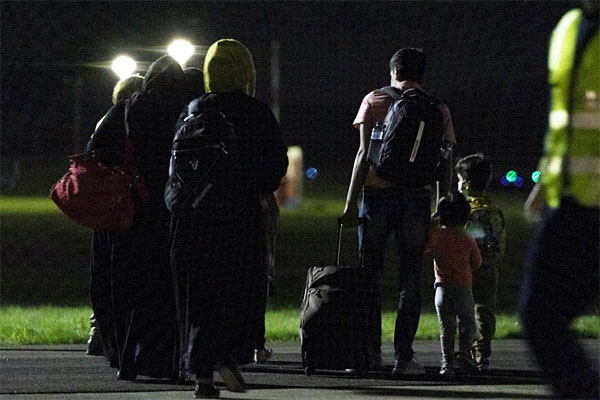
Afghan refugees will be temporarily housed in unused military housing in Oxfordshire under a new arrangement. Families who fled the war-torn country when the Taliban regained control two years ago will be moved into unoccupied Ministry of Defence houses in Watchfield and Shrivenham.
The arrangement will apply to those who had contributed to the UK’s military operations in their country, putting themselves at risk by working and fighting for the UK.
The Vale of White Horse District Council will act as de-facto landlords, leasing and managing the properties and taking responsibility for maintenance and repairs. Councillor Helen Pighills said: “We have a duty to help those who have put themselves in harm’s way by helping our country’s military operations in Afghanistan, and so we’re pleased to work closely with the Ministry of Defence to provide the care and support our guests need. By using government funding to provide important humanitarian support to our Afghan friends, we’re also able to put the foundations in place at the council to manage the properties which will help us begin the process of providing much-needed social housing and support for our Vale residents in the future.”
The arrangement will apply to those who had contributed to the UK’s military operations in their country, putting themselves at risk by working and fighting for the UK.
The Vale of White Horse District Council will act as de-facto landlords, leasing and managing the properties and taking responsibility for maintenance and repairs. Councillor Helen Pighills said: “We have a duty to help those who have put themselves in harm’s way by helping our country’s military operations in Afghanistan, and so we’re pleased to work closely with the Ministry of Defence to provide the care and support our guests need. By using government funding to provide important humanitarian support to our Afghan friends, we’re also able to put the foundations in place at the council to manage the properties which will help us begin the process of providing much-needed social housing and support for our Vale residents in the future.”
The arrangement will provide a suitable and stable home for around 18 months to 36 months, with the council using that time to help the families find and move into privately rented homes. During this time, the council will be working with county-wide partners to provide all the support the families need to live independently, including help with language, education and employment.
uk.news.yahoo.com
uk.news.yahoo.com
An Afghan family disembarks from an RAF Voyager

From: Colin Savill, Tuxford, Notts
Subject: Food Stories from Around the World
Tony,
Bastia, Corsica mid 1970s on a recovery of some Guards who had been training with the French Foreign Legion.
Accommodation for us Movers was a small hotel on the way to Bastia town. Our first evening the restaurant menu was of course in French. Two of us with limited schoolboy French did our best to translate and pass on the requirements of the team to the non-English speaking waiting staff (we survived!).
On arriving the second evening the owner's sister, who was visiting, had translated the whole menu into English, just for us.We were very grateful!
Regards
Colin
Subject: Food Stories from Around the World
Tony,
Bastia, Corsica mid 1970s on a recovery of some Guards who had been training with the French Foreign Legion.
Accommodation for us Movers was a small hotel on the way to Bastia town. Our first evening the restaurant menu was of course in French. Two of us with limited schoolboy French did our best to translate and pass on the requirements of the team to the non-English speaking waiting staff (we survived!).
On arriving the second evening the owner's sister, who was visiting, had translated the whole menu into English, just for us.We were very grateful!
Regards
Colin


From: Mick Craner, Yeovil, Somerset
Subject: Food Stories from Around the World
Hello Tony,
Very interesting that your first KFC was in Nassau. On May 6th or 7th 1969, myself and Fl Lt Paddy Hayes consumed our KFCs sitting on a wooden deck by the sea in Nassau. It was a beautiful sunny day and we dropped bits of chicken and the odd chip to the fish swimming below us. Oh! Happy Days.
Now one for ex Changi people - Who remembers "The Banana Leaf Apollo” a curry place on Cuff Road, Singapore? Good curry served on a banana leaf with rice, prawns and a large bottle of Tiger.
Cheers!
Mick
Subject: Food Stories from Around the World
Hello Tony,
Very interesting that your first KFC was in Nassau. On May 6th or 7th 1969, myself and Fl Lt Paddy Hayes consumed our KFCs sitting on a wooden deck by the sea in Nassau. It was a beautiful sunny day and we dropped bits of chicken and the odd chip to the fish swimming below us. Oh! Happy Days.
Now one for ex Changi people - Who remembers "The Banana Leaf Apollo” a curry place on Cuff Road, Singapore? Good curry served on a banana leaf with rice, prawns and a large bottle of Tiger.
Cheers!
Mick
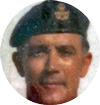

From: Terry Jackson, St Albans, Herts
Subject: Food Stories from Around the World
Hi Tony,
Great subject. Mine are all in Changi during the withdrawl of 1971:
No.1 Pops Keema Curry. You know what to expect when 4 jugs of water are put on the table.
No.2 Singapura Hotel Orchard Rd with Satay sticks and peanut sauce listening to jazz piano.
No.3 Eating street food in Bugis Street in the early hours and playing the street urchins at noughts and crosses. They would always let you go first. I never knew of anybody who beat them.
Lastly, Warrant Officer Joe Gough was the Officers' Mess manager at RAF Changi. He took pity on those of us there without our families and living in the Sergeants' Mess. Three of us were invited on a fairly regular basis to dine on the terrace at the back of the Officers' Mess looking out over Changi Creek. The officers were served out of the front door and we were served out of the back. Not sure if anybody knew. Lovely memories!
Regards
Terry
Subject: Food Stories from Around the World
Hi Tony,
Great subject. Mine are all in Changi during the withdrawl of 1971:
No.1 Pops Keema Curry. You know what to expect when 4 jugs of water are put on the table.
No.2 Singapura Hotel Orchard Rd with Satay sticks and peanut sauce listening to jazz piano.
No.3 Eating street food in Bugis Street in the early hours and playing the street urchins at noughts and crosses. They would always let you go first. I never knew of anybody who beat them.
Lastly, Warrant Officer Joe Gough was the Officers' Mess manager at RAF Changi. He took pity on those of us there without our families and living in the Sergeants' Mess. Three of us were invited on a fairly regular basis to dine on the terrace at the back of the Officers' Mess looking out over Changi Creek. The officers were served out of the front door and we were served out of the back. Not sure if anybody knew. Lovely memories!
Regards
Terry


From: David Powell, Princes Risborough, Bucks
Subject: Food Stories from Around the World
Hi Tony:
Posh Nosh! First encounter with Thousand Island Dressing (still my favorite) at Gander 2 Dec 1967, with F Team in Britannia 489 heading for Hickam (Hawaii) via McClellan and Offutt, back home 5 days later. Those were the days! Now it's probably a day return over the North Pole in a Voyager!
Best wishes
David Powell
F Team UK MAMS RAF Abingdon 1967-69
Subject: Food Stories from Around the World
Hi Tony:
Posh Nosh! First encounter with Thousand Island Dressing (still my favorite) at Gander 2 Dec 1967, with F Team in Britannia 489 heading for Hickam (Hawaii) via McClellan and Offutt, back home 5 days later. Those were the days! Now it's probably a day return over the North Pole in a Voyager!
Best wishes
David Powell
F Team UK MAMS RAF Abingdon 1967-69


RAF Scampton: Dambusters Officers' Mess Awarded Protected Status
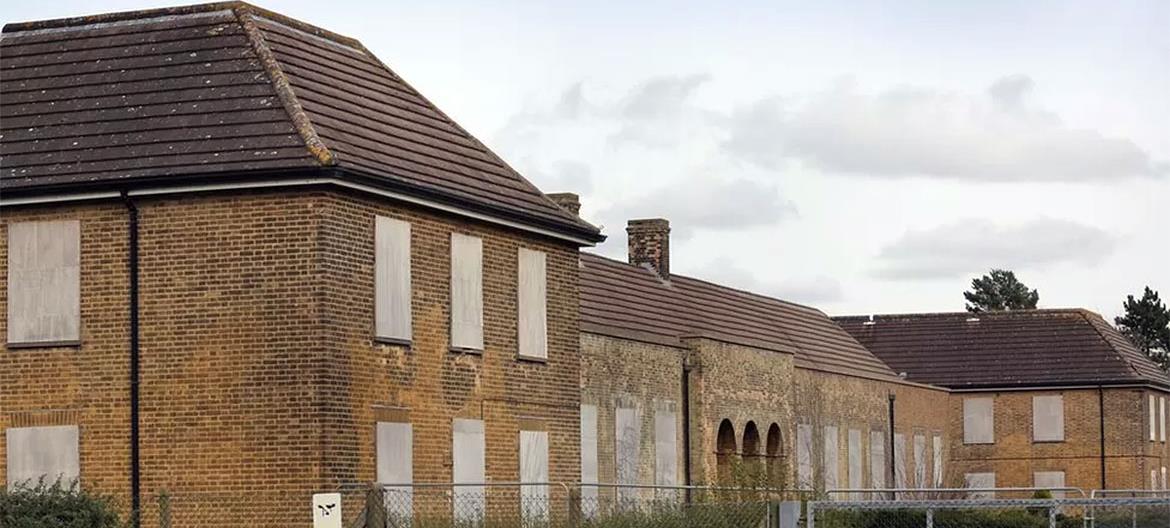
West Lindsey District Council previously said the former officers' mess building at RAF Scampton was "deteriorating rapidly"
The officers' mess building used by members of the famous Dambusters squadron at the former RAF Scampton has been given protected status. West Lindsey District Council applied in March for the building to be listed amid government plans to house up to 2,000 asylum seekers at the site. The success of the application "acknowledges the building's importance", the council said. The Home Office said "heritage assets" at the site would be protected.
RAF Scampton, near Lincoln, was where 617 Squadron - the unit famous for launching the "bouncing bomb" dam raids against Germany in World War II was founded. The officers' mess, which has now been officially recorded on the Historic England website as a Grade II-listed building, once provided social space and accommodation for RAF personnel.
Welcoming the listing, Trevor Young, leader of West Lindsey District Council, said: "This recognition of the high degree of special historical interest, specifically the base's role in some of the most famous actions of World War II, is a really positive outcome for the site, particularly as there remains an element of uncertainty around its short-term future."
The government's plan to house asylum seekers at the former Air Force station, which was also until recently the home of the Red Arrows, has been met with strong opposition. A judicial review into the proposals is due to take place at the end of this month.
Councillor Young said: "Custodians of listed buildings hold a privileged position, having an important role to play in protecting the nation's heritage for future generations. With that privilege comes a great responsibility to not only protect that asset, but also ensure it has a sustainable future." He added that he hoped the Home Office would "take these responsibilities seriously" as it went ahead with the asylum centre plans.
A government spokesperson said: "The Home Office has made it clear from the outset of this project that it recognises its responsibilities to take appropriate steps to ensure the heritage assets at RAF Scampton are protected and preserved. Security and operational management plans will be put in place to support this. We are confident our project, which will house asylum seekers in basic, safe and secure accommodation, meets the planning requirements."
bbc.com
RAF Scampton, near Lincoln, was where 617 Squadron - the unit famous for launching the "bouncing bomb" dam raids against Germany in World War II was founded. The officers' mess, which has now been officially recorded on the Historic England website as a Grade II-listed building, once provided social space and accommodation for RAF personnel.
Welcoming the listing, Trevor Young, leader of West Lindsey District Council, said: "This recognition of the high degree of special historical interest, specifically the base's role in some of the most famous actions of World War II, is a really positive outcome for the site, particularly as there remains an element of uncertainty around its short-term future."
The government's plan to house asylum seekers at the former Air Force station, which was also until recently the home of the Red Arrows, has been met with strong opposition. A judicial review into the proposals is due to take place at the end of this month.
Councillor Young said: "Custodians of listed buildings hold a privileged position, having an important role to play in protecting the nation's heritage for future generations. With that privilege comes a great responsibility to not only protect that asset, but also ensure it has a sustainable future." He added that he hoped the Home Office would "take these responsibilities seriously" as it went ahead with the asylum centre plans.
A government spokesperson said: "The Home Office has made it clear from the outset of this project that it recognises its responsibilities to take appropriate steps to ensure the heritage assets at RAF Scampton are protected and preserved. Security and operational management plans will be put in place to support this. We are confident our project, which will house asylum seekers in basic, safe and secure accommodation, meets the planning requirements."
bbc.com

From: Graham Allen, Cropwell Butler, Notts
Subject: Food Stories from Around the World
Hi Tony,
With regards to food on our travels, I had two very memorable occasions. The first one was when I was flying with Antonov. We picked up three helicopters for the UN from an army base in Belgrade. Loading finished and we’re invited to have lunch in the mess. Well, it’s the first time I’ve had lamb stew and peaches and strawberry ice cream all served on the same plate at the same time. No knife and fork just a spoon. The rest of the crew just laughed!
The best one though was when we flew into the Seychelle Islands with Antonov delivering satellite tracking equipment for the American ARTS programme. Arrived late at night, checked into the hotel. Good night's sleep then headed for breakfast in the large open air dining room. I have never seen such a vast array of food in my life. 10 different cereals, 10 assorted fruit juices, sliced meat, cheeses, sausages, bacon, eggs, 15 different Danish pastries, Madeira cake and jams, local tea and coffee from the plantation across the road and breads, rolls etc. To say we were stuffed was an understatement and we were there for ten very happy days!
All the best
Graham
Subject: Food Stories from Around the World
Hi Tony,
With regards to food on our travels, I had two very memorable occasions. The first one was when I was flying with Antonov. We picked up three helicopters for the UN from an army base in Belgrade. Loading finished and we’re invited to have lunch in the mess. Well, it’s the first time I’ve had lamb stew and peaches and strawberry ice cream all served on the same plate at the same time. No knife and fork just a spoon. The rest of the crew just laughed!
The best one though was when we flew into the Seychelle Islands with Antonov delivering satellite tracking equipment for the American ARTS programme. Arrived late at night, checked into the hotel. Good night's sleep then headed for breakfast in the large open air dining room. I have never seen such a vast array of food in my life. 10 different cereals, 10 assorted fruit juices, sliced meat, cheeses, sausages, bacon, eggs, 15 different Danish pastries, Madeira cake and jams, local tea and coffee from the plantation across the road and breads, rolls etc. To say we were stuffed was an understatement and we were there for ten very happy days!
All the best
Graham

From: Barry Tappenden, Shortstown, Beds
Subject: First Tandem Jump at 78!
Good evening Tony,
Thought you may like to see what this silly ****** is about to do in a few weeks time.
On the 1st October 2023, at 1430hrs, I will be jumping out of an aircraft at 10,000 feet in a tamden jump to raise money to erect a permanent monument to my father, Cpl Ted "Ham and Jam" Tappenden and Major John Howard. A monument will show the Major and Ted sending out the codes for the successful capture of the Pegasus and Horsa bridges (intact) on D-Day, 6th June 1944... Ham and Jam.
I have created a JustGiving page: https://www.justgiving.com/crowdfunding/barry-tappenden-1... please give generously as we must always remember the bravery and courage of the men of the Coup de Main.
I have attached some info about the sky-dive and my Father Cpl Ted “Ham and Jam” Tappenden plus some info on the monument.
Subject: First Tandem Jump at 78!
Good evening Tony,
Thought you may like to see what this silly ****** is about to do in a few weeks time.
On the 1st October 2023, at 1430hrs, I will be jumping out of an aircraft at 10,000 feet in a tamden jump to raise money to erect a permanent monument to my father, Cpl Ted "Ham and Jam" Tappenden and Major John Howard. A monument will show the Major and Ted sending out the codes for the successful capture of the Pegasus and Horsa bridges (intact) on D-Day, 6th June 1944... Ham and Jam.
I have created a JustGiving page: https://www.justgiving.com/crowdfunding/barry-tappenden-1... please give generously as we must always remember the bravery and courage of the men of the Coup de Main.
I have attached some info about the sky-dive and my Father Cpl Ted “Ham and Jam” Tappenden plus some info on the monument.

The photograph shows my Father and Major John Howard on a pre D-Day exercise. The monument, we hope will be created by Amy Goodman, sculptor and portrait artist who has created many military (Airborne) images. It will show my father sending out the code words for the capture of the two bridges, Pegasus and Horsa (Ham and Jam).
The words Ham and Jam are widely known throughout the military world and my thoughts are that we must never forget the courage and bravery of the members of the Coup de Main and all veterans and service men and women.
It would be a tribute to them when we say “We will remember them – Ham and bloody Jam”.
The words Ham and Jam are widely known throughout the military world and my thoughts are that we must never forget the courage and bravery of the members of the Coup de Main and all veterans and service men and women.
It would be a tribute to them when we say “We will remember them – Ham and bloody Jam”.
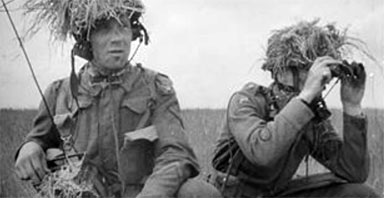
This is a story by a son of Cpl Ted “Ham & Jam” Tappenden
Dad was a member of the elite “Coup de Main” force sent to Normandy on the eve of D-Day.
He was the Company Clerk, not a sit on your hands job, but a member of the 6th Airborne Division, Ox & Bucks Light Infantry. It was an elite company of men, led by Major John Howard, whose job was to capture “intact” the two canal bridges over the River Orne; a very daring and dangerous operation. 6 Horsa Gliders, 3 to each bridge, were loaded with men and equipment to the maximum. Dad was Major Howard’s radio operator and had to ensure that he was at the Major’s side at all times.
My father was in No 1 glider piloted by Sgt Walwark, whose aviation skills enabled him to land a few metres from the bridge with the aircraft's nose pushed up against the barbed wire. The time was 00.06am, 6th June 1944; the invasion force was still 5 hours away at sea.
The stealth and secrecy of the operation ensured that the German guards were unaware of the landing. So-much-so that there was little resistance until the first grenades exploded in the pill box. Lt Brotheridge led his men across the bridge firing and screaming (I’m told that this effect would put the fear into anyone) at the entrenched Germans.
Lt Brotheridge suffered a fatal gun shot wound and it is believed that he was the first man to die from enemy action on D-Day. The detachment of Royal Engineers swung under the bridge and found no explosives. The Major was pleased with the result and remembering his orders, “Hold until relieved”. At this point he turned to my father and ordered him to send the code to the paratroopers that the bridges were captured intact.
The code was “Ham and Jam”, and dad sent the message: “Hello Four Dog, Ham & Jam, Ham & Jam”. He transmitted for some considerable time unaware that the radio operator he was sending to had been killed when his chute failed to open. After much frustration of not receiving a reply, dad is well remembered for: Hello 4 Dog, Hello 4 Dog, Ham & Jam, Ham & Bloody Jam, where the hell are you”.
My family and I have had the pleasure and honour of taking some of the veterans back to Normandy every year for the past 16 years. We would sit with them at Pegasus Bridge listening in awe to their stories - sad, comical, boastful and heroic. The Coup de main force was made up of ordinary London lads, who were trained, coaxed and encouraged and who performed one of the most successful operations in WWII.
He was the Company Clerk, not a sit on your hands job, but a member of the 6th Airborne Division, Ox & Bucks Light Infantry. It was an elite company of men, led by Major John Howard, whose job was to capture “intact” the two canal bridges over the River Orne; a very daring and dangerous operation. 6 Horsa Gliders, 3 to each bridge, were loaded with men and equipment to the maximum. Dad was Major Howard’s radio operator and had to ensure that he was at the Major’s side at all times.
My father was in No 1 glider piloted by Sgt Walwark, whose aviation skills enabled him to land a few metres from the bridge with the aircraft's nose pushed up against the barbed wire. The time was 00.06am, 6th June 1944; the invasion force was still 5 hours away at sea.
The stealth and secrecy of the operation ensured that the German guards were unaware of the landing. So-much-so that there was little resistance until the first grenades exploded in the pill box. Lt Brotheridge led his men across the bridge firing and screaming (I’m told that this effect would put the fear into anyone) at the entrenched Germans.
Lt Brotheridge suffered a fatal gun shot wound and it is believed that he was the first man to die from enemy action on D-Day. The detachment of Royal Engineers swung under the bridge and found no explosives. The Major was pleased with the result and remembering his orders, “Hold until relieved”. At this point he turned to my father and ordered him to send the code to the paratroopers that the bridges were captured intact.
The code was “Ham and Jam”, and dad sent the message: “Hello Four Dog, Ham & Jam, Ham & Jam”. He transmitted for some considerable time unaware that the radio operator he was sending to had been killed when his chute failed to open. After much frustration of not receiving a reply, dad is well remembered for: Hello 4 Dog, Hello 4 Dog, Ham & Jam, Ham & Bloody Jam, where the hell are you”.
My family and I have had the pleasure and honour of taking some of the veterans back to Normandy every year for the past 16 years. We would sit with them at Pegasus Bridge listening in awe to their stories - sad, comical, boastful and heroic. The Coup de main force was made up of ordinary London lads, who were trained, coaxed and encouraged and who performed one of the most successful operations in WWII.
Update 14 October 2023
I’m afraid due to very strict H&S regulations, they wouldn’t let me jump. I was 2kg over the legal requirement! BUT, I have rescheduled for the 31st March 2024, Easter Sunday. I’ve been told I have to do it arms outstretched 😂. Just hope I’m not tempted by too much Christmas cheer!
The wife said, "Don’t eat anything fatty."
I responded, "You mean chips etc..."
She said, "No, just don’t eat anything, FATTY!"
Best regards,
Barry
I’m afraid due to very strict H&S regulations, they wouldn’t let me jump. I was 2kg over the legal requirement! BUT, I have rescheduled for the 31st March 2024, Easter Sunday. I’ve been told I have to do it arms outstretched 😂. Just hope I’m not tempted by too much Christmas cheer!
The wife said, "Don’t eat anything fatty."
I responded, "You mean chips etc..."
She said, "No, just don’t eat anything, FATTY!"
Best regards,
Barry
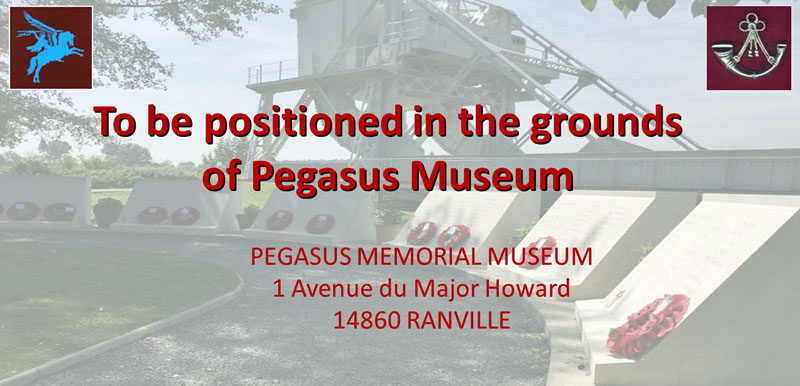


RAF delivers UK humanitarian aid for Palestinian civilians in Gaza
25 October 2023. RAF aircraft has delivered humanitarian aid to Egypt for those civilians still in Gaza as Israel's bombardment has left many without food, water or fuel. A C-17 aircraft left RAF Brize Norton in Oxfordshire with 21 tonnes of aid, including 76,800 wound care packs. Each pack includes a tray, a pair of large cuffed Nitrile gloves, a white waste bag, a towel, a white plastic apron, four-ply swabs, a measuring tape with a pain guide, and tissue-backed sterile dressings.
The UK has also delivered a temporary warehouse and mechanical handling equipment, including two forklifts, to be set up close to the Rafa border crossing connecting Egypt and the Gaza Strip. Supplies will be handed out via the Egyptian Red Crescent, which requested items that meet the most urgent needs of the Palestinian people in Gaza.
Independent TV
The UK has also delivered a temporary warehouse and mechanical handling equipment, including two forklifts, to be set up close to the Rafa border crossing connecting Egypt and the Gaza Strip. Supplies will be handed out via the Egyptian Red Crescent, which requested items that meet the most urgent needs of the Palestinian people in Gaza.
Independent TV

From: Ian Berry, Eastleaze, Swindon, Wilts
Subject: The times they are a changin!
Hi Tony,
Subject: The times they are a changin!
Hi Tony,
The times they are a changin!
I saw the following and copied from "The Royal Air Force Friends" Facebook page. Submitted by Ray Smith on 8 October at 08.26.
"So sad the way the RAF is now. This permitting of beards is crass and lately they are debating whether to lose Carol Vorderman as an RAF Ambassador. She's getting political and taking sides and knocking the Govt - just get rid!
This is the latest - the pic below is a Trans RAF thingy (centre) and words fail me."
Ian
"So sad the way the RAF is now. This permitting of beards is crass and lately they are debating whether to lose Carol Vorderman as an RAF Ambassador. She's getting political and taking sides and knocking the Govt - just get rid!
This is the latest - the pic below is a Trans RAF thingy (centre) and words fail me."
Ian

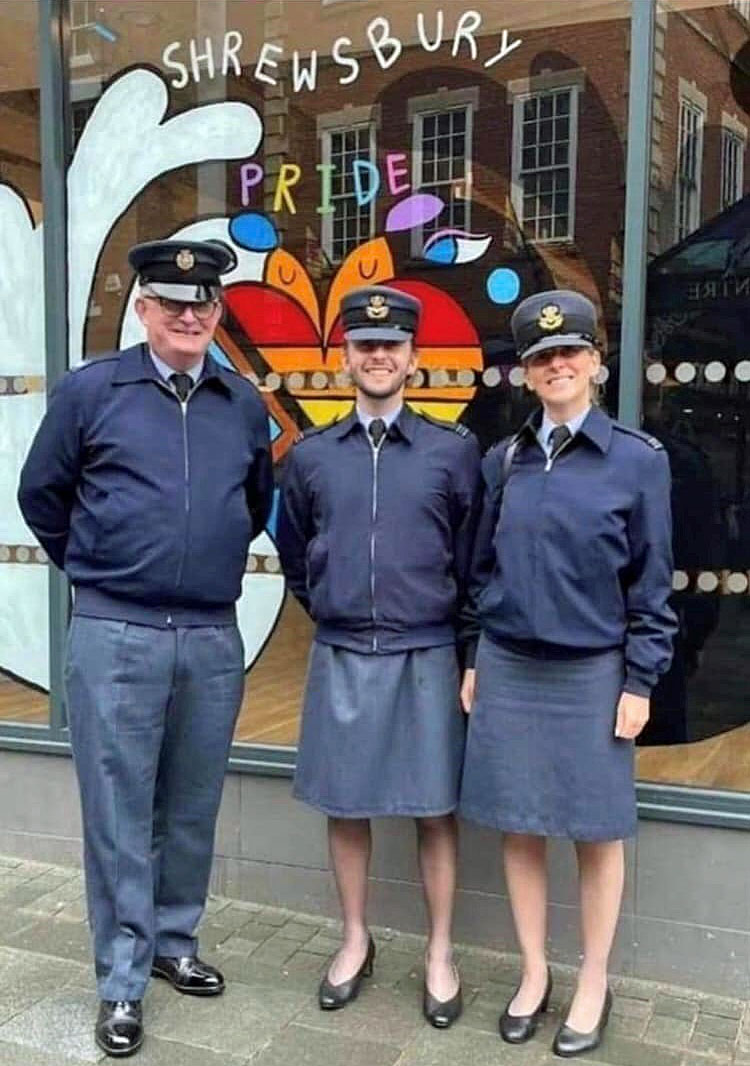

Carol Vorderman UNDER FIRE with RAF after anti-Government rants

From: Alex Masson, Tunbridge Wells, Kent
Subject: Some News from the Home Front
Hi Tony,
I may have no story to tell about Food Around the World as the place where I was posted was on Christmas Island - and the food there was steak and kidney pie (to die for), bangers and mash, and good old fish and chips! However, I do have some news...
Subject: Some News from the Home Front
Hi Tony,
I may have no story to tell about Food Around the World as the place where I was posted was on Christmas Island - and the food there was steak and kidney pie (to die for), bangers and mash, and good old fish and chips! However, I do have some news...

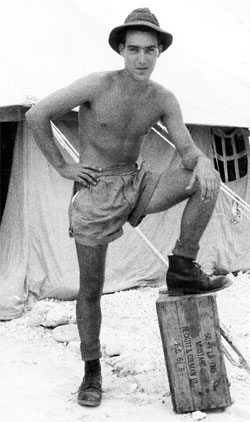
I have just received my Nuclear Test Medal from the MoD, only 66 years late! Still, we have kept the peace for that length of time and hopefully it will last a little longer.
I was only 20 years of age when I took part in Operation Grapple in 1957. Are there other ‘Movers’ to be awarded this medal, I wonder? It would be good to know of anyone else out there who has received the medal too. Most of my friends are no longer with us. However, their next of kin can apply for it on their behalf.
The medal itself is silver and shows the King on one side and a design of olive branches and the atom on the other. The ribbon has many colours including the blue of the bright blue sky and the Pacific ocean, the yellow sand, and red and white which could represent the swirling mass of the heat flash!
Kind regards,
Alex
I was only 20 years of age when I took part in Operation Grapple in 1957. Are there other ‘Movers’ to be awarded this medal, I wonder? It would be good to know of anyone else out there who has received the medal too. Most of my friends are no longer with us. However, their next of kin can apply for it on their behalf.
The medal itself is silver and shows the King on one side and a design of olive branches and the atom on the other. The ribbon has many colours including the blue of the bright blue sky and the Pacific ocean, the yellow sand, and red and white which could represent the swirling mass of the heat flash!
Kind regards,
Alex
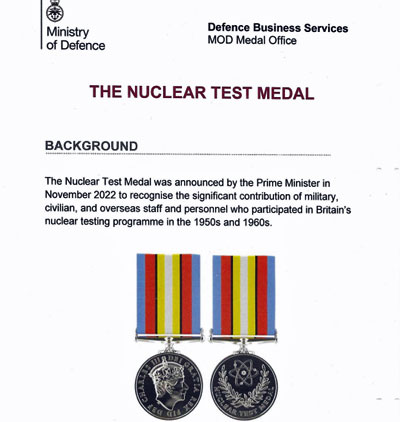

From silk to plastic to paper: The evolution of the poppy
Remembrance poppies throughout the decades
While the design of the remembrance poppy has undergone several changes since its inception in 1921, the profound symbolism behind it remains unwavering. The poppy pays tribute to the sacrifice of those who laid down their lives during war.
The funds from selling the poppies in the UK go to The Royal British Legion, a charity that has supported the Armed Forces community since its inception in 1921, the same year that the poppy became its symbol.
The poppy is made up of red petals held together by a black centre with a green stem, and sometimes with the addition of a leaf. This has remained the same for more than 100 years, but the materials used to create that symbol have changed throughout the decades. The red petals symbolise the blood that has been shed on the battlefield, while the black centre represents mourning for those who perished. From its earliest handmade versions to the modern, mass-produced pins, the design and materials used to create the remembrance poppy have gone through various changes.
The roaring 20s – a different poppy to suit every wallet (and child). The first poppies were made with crude oil, more exactly a form of distilled crude oil known as bitumen. Bitumen is commonly used for the construction of roads, as it boasts adhesive and waterproofing qualities. The semi-hard petroleum substance was moulded to create the black centre of the poppy, serving as an effective adhesive to bind the flower together.
As for the petals, the public of the 1920s had four different poppy materials to choose from depending on their budget. The ones that could afford it opted for a large poppy made from silk. There was also a smaller poppy made from cotton or lawn. Lawn is a type of fabric usually made with cotton. It has a silky texture due to having a high thread count.
Finally, cardboard poppies were designed with the youngest members of post-WWI society in mind. The child-friendly poppy was the most affordable of the four different types of poppies and ensured that an understanding of the importance of honouring those who made the ultimate sacrifice was instilled from a young age.
The 1930s turn a new leaf. During the 1930s the poppy saw the addition of a small green leaf and a centre that was made from metal. The materials that the poppy was made from remained the same, but they were now combined – the poppy became double-layered. The under layer was made from lawn cloth, with an upper layer of silk.
Poppies during the Second World War. The poppy continued to serve as a beacon of hope and a symbol of remembrance during the Second World War. The design and materials of the poppies reflected the scarcity of resources during those years. The layers of petals dropped from four to two and silk poppies were made in far fewer numbers. Paper and card became the primary materials for making poppies. It was cheap, easy to work with and readily available, which meant that poppies could be produced en masse. This practical and resource-efficient solution meant the poppy could be produced in large quantities to raise more funds for veterans and their families.
A post-war return to elegance. The 1950s saw the return of the two layers of petals and the introduction of a new material – red felt. With war scarcity and rationing coming to an end, the cardboard poppy was phased out in favour of a more opulent choice. The felt petals were held together by a wire stem. The leaf had been lost.
Swinging 60s see tradition mixed with modernity. Poppies retained their characteristic red petals and black centres while embracing a minimalist design that epitomised the 1960s aesthetic. A one-piece petal was introduced in 1967. The redesign also saw the traditionally bitumen-made centre replaced with plastic, and the once-wire stem was likewise transitioned to a plastic counterpart, marking the first time plastic was used to make the poppy. The new minimalist poppy remained leafless.
The leaf returns in 1987. Twenty years later the iconic poppy was redesigned once again, returning to a more traditional look. It emerged that the public preferred poppies with leaves, so the green detail was added back in for the first time since it was taken away in the 1950s. The leaf became even bigger than before and remains a prominent feature of the poppy until this day.
In 2023 the poppy becomes plastic-free. Millions of Britons can now buy a poppy that is completely plastic-free and 100% recyclable. This year saw the first redesign of the historic symbol of remembrance in 28 years. The RBL said analysis from scientists suggests the new design could reduce emissions by 40%. The new flowers are made from 100% paper which is produced from a blend of renewable fibres from responsible sources. One of those sources is the offcut created during the production of paper coffee cups, which the RBL says 50% of the paper is made from. The Scottish poppy, which is a four-petalled design rather than the usual two, is also plastic-free and recyclable.
The enduring sales of millions of poppies during the month of November represent a collective commitment to remembering the horrors of war and paying tribute to those who have died. All funds raised from the Poppy Appeal go towards supporting Armed Forces personnel, veterans and their families. Such assistance includes alleviating financial burdens, fostering mental well-being, helping with housing and aiding in recovery from trauma or illness.
forces.net
The funds from selling the poppies in the UK go to The Royal British Legion, a charity that has supported the Armed Forces community since its inception in 1921, the same year that the poppy became its symbol.
The poppy is made up of red petals held together by a black centre with a green stem, and sometimes with the addition of a leaf. This has remained the same for more than 100 years, but the materials used to create that symbol have changed throughout the decades. The red petals symbolise the blood that has been shed on the battlefield, while the black centre represents mourning for those who perished. From its earliest handmade versions to the modern, mass-produced pins, the design and materials used to create the remembrance poppy have gone through various changes.
The roaring 20s – a different poppy to suit every wallet (and child). The first poppies were made with crude oil, more exactly a form of distilled crude oil known as bitumen. Bitumen is commonly used for the construction of roads, as it boasts adhesive and waterproofing qualities. The semi-hard petroleum substance was moulded to create the black centre of the poppy, serving as an effective adhesive to bind the flower together.
As for the petals, the public of the 1920s had four different poppy materials to choose from depending on their budget. The ones that could afford it opted for a large poppy made from silk. There was also a smaller poppy made from cotton or lawn. Lawn is a type of fabric usually made with cotton. It has a silky texture due to having a high thread count.
Finally, cardboard poppies were designed with the youngest members of post-WWI society in mind. The child-friendly poppy was the most affordable of the four different types of poppies and ensured that an understanding of the importance of honouring those who made the ultimate sacrifice was instilled from a young age.
The 1930s turn a new leaf. During the 1930s the poppy saw the addition of a small green leaf and a centre that was made from metal. The materials that the poppy was made from remained the same, but they were now combined – the poppy became double-layered. The under layer was made from lawn cloth, with an upper layer of silk.
Poppies during the Second World War. The poppy continued to serve as a beacon of hope and a symbol of remembrance during the Second World War. The design and materials of the poppies reflected the scarcity of resources during those years. The layers of petals dropped from four to two and silk poppies were made in far fewer numbers. Paper and card became the primary materials for making poppies. It was cheap, easy to work with and readily available, which meant that poppies could be produced en masse. This practical and resource-efficient solution meant the poppy could be produced in large quantities to raise more funds for veterans and their families.
A post-war return to elegance. The 1950s saw the return of the two layers of petals and the introduction of a new material – red felt. With war scarcity and rationing coming to an end, the cardboard poppy was phased out in favour of a more opulent choice. The felt petals were held together by a wire stem. The leaf had been lost.
Swinging 60s see tradition mixed with modernity. Poppies retained their characteristic red petals and black centres while embracing a minimalist design that epitomised the 1960s aesthetic. A one-piece petal was introduced in 1967. The redesign also saw the traditionally bitumen-made centre replaced with plastic, and the once-wire stem was likewise transitioned to a plastic counterpart, marking the first time plastic was used to make the poppy. The new minimalist poppy remained leafless.
The leaf returns in 1987. Twenty years later the iconic poppy was redesigned once again, returning to a more traditional look. It emerged that the public preferred poppies with leaves, so the green detail was added back in for the first time since it was taken away in the 1950s. The leaf became even bigger than before and remains a prominent feature of the poppy until this day.
In 2023 the poppy becomes plastic-free. Millions of Britons can now buy a poppy that is completely plastic-free and 100% recyclable. This year saw the first redesign of the historic symbol of remembrance in 28 years. The RBL said analysis from scientists suggests the new design could reduce emissions by 40%. The new flowers are made from 100% paper which is produced from a blend of renewable fibres from responsible sources. One of those sources is the offcut created during the production of paper coffee cups, which the RBL says 50% of the paper is made from. The Scottish poppy, which is a four-petalled design rather than the usual two, is also plastic-free and recyclable.
The enduring sales of millions of poppies during the month of November represent a collective commitment to remembering the horrors of war and paying tribute to those who have died. All funds raised from the Poppy Appeal go towards supporting Armed Forces personnel, veterans and their families. Such assistance includes alleviating financial burdens, fostering mental well-being, helping with housing and aiding in recovery from trauma or illness.
forces.net
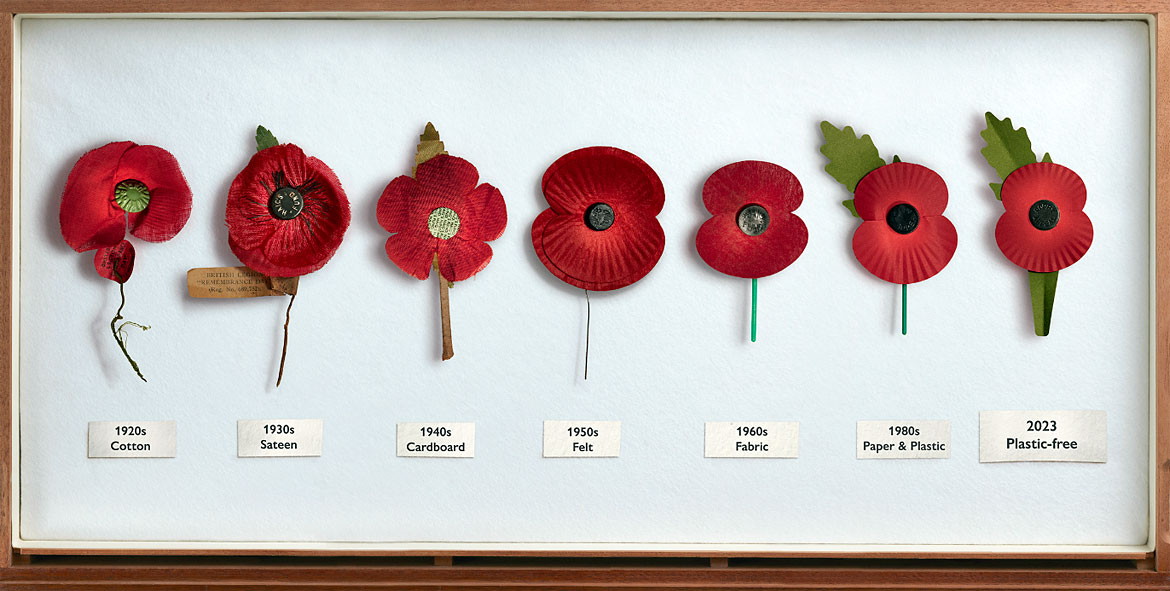

From: Ian Berry, Eastleaze, Swindon, Wilts
Subject: Food Stories from Around the World
Hi Tony,
My first pizza was in Duluth, Minnesota (1973) during an unexpected 10 day stopover when we lost an engine on a Belfast with a second overheating! Steve Broadhurst [now in Melbourne] was with me and had done a recent detachment in Dulles and so introduced me to pizzas.
In 1980 sat in a restaurant in Shreveport, Louisiana (Barksdale AFB) at breakfast I tried grits for the first... and last time. Aptly named as tasted like gravel!
Also in the early 70s in Ottawa, being a bit of a non-worldly peasant then, I asked the waiter for ketchup to accompany my steak. Instead I was confronted by the Manageress who publicly harangued me and stated I would not destroy a great piece of meat in her restaurant!
Not food but... again in the early 70s the vending machine in our motel in San Bernardino (Norton AFB) stocked root beer. I had never tried it before and thought “beer” and so dropped 6 cans. First sip....WTF! Never tried again, ever.
Ian
Subject: Food Stories from Around the World
Hi Tony,
My first pizza was in Duluth, Minnesota (1973) during an unexpected 10 day stopover when we lost an engine on a Belfast with a second overheating! Steve Broadhurst [now in Melbourne] was with me and had done a recent detachment in Dulles and so introduced me to pizzas.
In 1980 sat in a restaurant in Shreveport, Louisiana (Barksdale AFB) at breakfast I tried grits for the first... and last time. Aptly named as tasted like gravel!
Also in the early 70s in Ottawa, being a bit of a non-worldly peasant then, I asked the waiter for ketchup to accompany my steak. Instead I was confronted by the Manageress who publicly harangued me and stated I would not destroy a great piece of meat in her restaurant!
Not food but... again in the early 70s the vending machine in our motel in San Bernardino (Norton AFB) stocked root beer. I had never tried it before and thought “beer” and so dropped 6 cans. First sip....WTF! Never tried again, ever.
Ian


From: Colin Eyre, Bridgend, Glamorgan
Subject: Food Stories from Around the World
Hi Tony,
Just a couple of thoughts. Like you, we also visited Cagliari, but we had giant prawns, they were HUGE. Whilst serving in Wildenrath I, along with Corporal Derek Baker, was tasked with a job at Brussels airport. Once our flight had been and gone, we went looking for somewhere to eat. We were told about a staff canteen and that’s where we went. They had steak and chips on the menu which suited us. It was the best steak I have ever eaten. Being somewhat naïve we didn’t question where it had come from but it was later suggested that what we had enjoyed had once run at Ascot!
The best airmans' mess I have eaten in was in Changi, where the choice of food was superb. On a sad note after a trip to Denmark I was telling my wife about the venison we had enjoyed in our hotel. My eldest child overheard us talking and accused me of ruining Christmas as we had eaten Rudolph! Such is life.
Regards,
Colin
Subject: Food Stories from Around the World
Hi Tony,
Just a couple of thoughts. Like you, we also visited Cagliari, but we had giant prawns, they were HUGE. Whilst serving in Wildenrath I, along with Corporal Derek Baker, was tasked with a job at Brussels airport. Once our flight had been and gone, we went looking for somewhere to eat. We were told about a staff canteen and that’s where we went. They had steak and chips on the menu which suited us. It was the best steak I have ever eaten. Being somewhat naïve we didn’t question where it had come from but it was later suggested that what we had enjoyed had once run at Ascot!
The best airmans' mess I have eaten in was in Changi, where the choice of food was superb. On a sad note after a trip to Denmark I was telling my wife about the venison we had enjoyed in our hotel. My eldest child overheard us talking and accused me of ruining Christmas as we had eaten Rudolph! Such is life.
Regards,
Colin


From: Mark Stephenson, Dieppe, NB
Subject: Food Stories from Around the World
Hey Tony,
Sorry for the last minute submission, I am getting back into the routine after we completed a cross-Canada road trip a couple of weeks ago (BC to NS in 6 weeks in an RV). Fabulous experience!
Regarding food experiences around the world, on my first team trip in Sep '85, I remember stopping with the team at a drive-in restaurant in Rapid City, South Dakota. The meal was traditional American fare (burgers, hot dogs, fries etc.) served by waitresses on roller skates. The team included Jim Bissel, Steve Perry, Pete Mahon and Dave Spencer. I rented an old, huge American rent-a-wreck car as team transport which was fitting for the drive-in experience. Incidentally this was the trip that Chris Goss referred to in a previous edition of the OBA newsletter reminding me that on departure from Ellesworth AFB I discovered as the Herc started up that I left my imprest in the hotel safe. It was recovered along with me on a later Herc flight.
Trips to Hong Kong were always an opportunity to experience a good feast on an Aberdeen Harbour floating restaurant. On one trip, I remember Steve Tomlinson taking my team for an authentic Chinese meal at someone’s home (not his!). We met him at the hotel and walked to the location. We climbed a few flights of stairs in a high-rise block and were welcomed by the family. A great experience of authentic homemade Chinese food. Steve also occasionally hosted us at his home from where we could watch aircraft coming into land at Kai Tak as they turned before Checkerboard Hill.
Whenever a trip was deemed by Group to be meals on “actuals” there was always an opportunity (normally on the co-pilot’s tab) to experience many choices on the menu of the chosen restaurant. A notable occurrence was in Dec '87 in Tanagara, Greece, picking up F4J freight with Tim Pyne & Joe Wilkes. Fantastic Greek meal followed next day by quite a few sore heads on the departure. The most notable stop was in Bombay (Mumbai) at the Leela Penta Hotel. Colin Hawson, SAC Dinger Bell and I joined the 47 Sqn crew, who picked us up after 7 days in Kathmandu, for a sumptuous Indian feast along with a show featuring Indian dance and music. A real authentic experience.
Subject: Food Stories from Around the World
Hey Tony,
Sorry for the last minute submission, I am getting back into the routine after we completed a cross-Canada road trip a couple of weeks ago (BC to NS in 6 weeks in an RV). Fabulous experience!
Regarding food experiences around the world, on my first team trip in Sep '85, I remember stopping with the team at a drive-in restaurant in Rapid City, South Dakota. The meal was traditional American fare (burgers, hot dogs, fries etc.) served by waitresses on roller skates. The team included Jim Bissel, Steve Perry, Pete Mahon and Dave Spencer. I rented an old, huge American rent-a-wreck car as team transport which was fitting for the drive-in experience. Incidentally this was the trip that Chris Goss referred to in a previous edition of the OBA newsletter reminding me that on departure from Ellesworth AFB I discovered as the Herc started up that I left my imprest in the hotel safe. It was recovered along with me on a later Herc flight.
Trips to Hong Kong were always an opportunity to experience a good feast on an Aberdeen Harbour floating restaurant. On one trip, I remember Steve Tomlinson taking my team for an authentic Chinese meal at someone’s home (not his!). We met him at the hotel and walked to the location. We climbed a few flights of stairs in a high-rise block and were welcomed by the family. A great experience of authentic homemade Chinese food. Steve also occasionally hosted us at his home from where we could watch aircraft coming into land at Kai Tak as they turned before Checkerboard Hill.
Whenever a trip was deemed by Group to be meals on “actuals” there was always an opportunity (normally on the co-pilot’s tab) to experience many choices on the menu of the chosen restaurant. A notable occurrence was in Dec '87 in Tanagara, Greece, picking up F4J freight with Tim Pyne & Joe Wilkes. Fantastic Greek meal followed next day by quite a few sore heads on the departure. The most notable stop was in Bombay (Mumbai) at the Leela Penta Hotel. Colin Hawson, SAC Dinger Bell and I joined the 47 Sqn crew, who picked us up after 7 days in Kathmandu, for a sumptuous Indian feast along with a show featuring Indian dance and music. A real authentic experience.

Apart from not being able to get used to the Norwegian taste for pickled fish for breakfast, I did get used over 6 days at King Faisal airbase in Jordan in November '86, to the servings of goat meat in different forms. We were there to recover a broken Chinook and some chaps from Hereford. Along with Don Milburn, Norm Gage and Dinger Bell, we also had the opportunity to do some night work with a 47 Sqn Special Forces crew and the aforementioned Hereford chaps.
On deployments to a location where MCSU (Mobile Catering Support Unit – Hullavington) were deployed we were always well fed. They used to deploy to Tirstrup, Denmark in support of the Jaguar force as well as on IALCE exercises and always provided excellent fare. When I moved to Upavon to become an exercise loggie, Steve Harpum (whom I replaced) made sure that I knew about the importance of including MCSU in exercise tasking – a great morale booster in the field!
Finally, thinking of food on exercises, I always remember driving around the pan at Lyneham on Ex Fast Buzzard in Sep '87 and being well received by hungry movers who were loading Hercs in the early hours and who really appreciated a delivery of a warm egg and bacon butty from the mess.
Regards,
Mark Stephenson
On deployments to a location where MCSU (Mobile Catering Support Unit – Hullavington) were deployed we were always well fed. They used to deploy to Tirstrup, Denmark in support of the Jaguar force as well as on IALCE exercises and always provided excellent fare. When I moved to Upavon to become an exercise loggie, Steve Harpum (whom I replaced) made sure that I knew about the importance of including MCSU in exercise tasking – a great morale booster in the field!
Finally, thinking of food on exercises, I always remember driving around the pan at Lyneham on Ex Fast Buzzard in Sep '87 and being well received by hungry movers who were loading Hercs in the early hours and who really appreciated a delivery of a warm egg and bacon butty from the mess.
Regards,
Mark Stephenson

From: Scott Parker, Gloucester
Subject: Keith Parker's Arrangements
Subject: Keith Parker's Arrangements
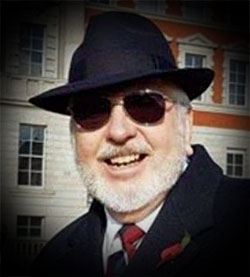
Keith Parker's Arrangements
Dad's funeral will take place on Thursday the 16th of November at 12 pm at St Michael & All Angels Church, Canon Square, Melksham, SN12 6LX. There is a pay and display car park nearby which also backs onto the wake venue.
Family flowers only please, but donations can be made to the charity Action for Pulmonary Fibrosis on the day or online using the QR code below or the link: https://www.justgiving.com/page/scott-parker-1698243410603
Family flowers only please, but donations can be made to the charity Action for Pulmonary Fibrosis on the day or online using the QR code below or the link: https://www.justgiving.com/page/scott-parker-1698243410603
Anyone who knew him is welcome to join us but please could you let us know if you plan to attend by emailing me at: KP.nuts106@gmail.com
Please use Mum's e-mail address for messages of condolence and stories of Dad: daphne-parker@blueyonder.co.uk
We look forward to seeing you on the day.
Scott
Please use Mum's e-mail address for messages of condolence and stories of Dad: daphne-parker@blueyonder.co.uk
We look forward to seeing you on the day.
Scott


Please note that there will not be a November newsletter
I will be travelling to South and Central America mid-November to mid-December, so there will not be a newsletter at the end of November (It will be a "Romancing the Stone" adventure!).
Cheers!
Tony
Cheers!
Tony
This Newsletter is Dedicated
to the Memories of
Keith Parker (RAF)
James Eade (RAF)
Regan Mitchell (RNZAF)
Robert "Bob" Andrews (RAF)
to the Memories of
Keith Parker (RAF)
James Eade (RAF)
Regan Mitchell (RNZAF)
Robert "Bob" Andrews (RAF)
Tony Gale
ukmamsoba@gmail.com
ukmamsoba@gmail.com







